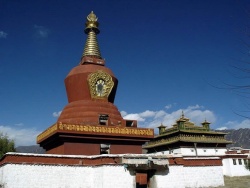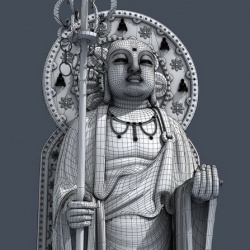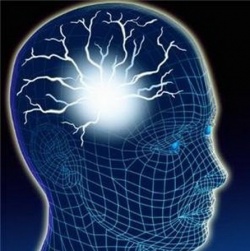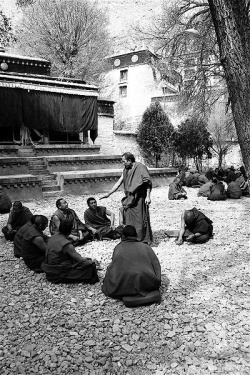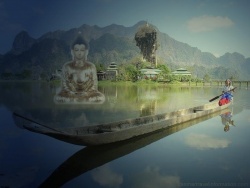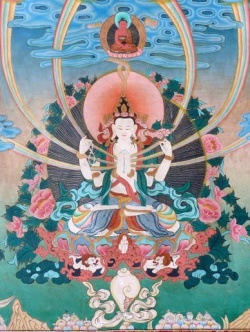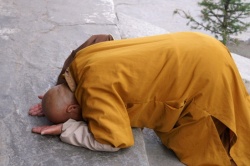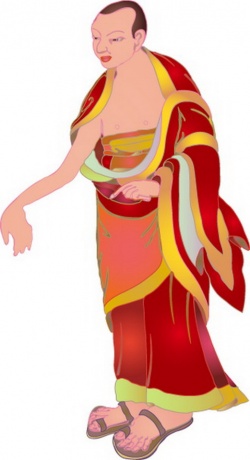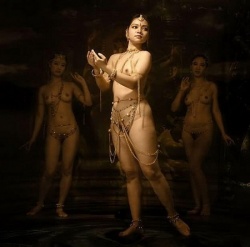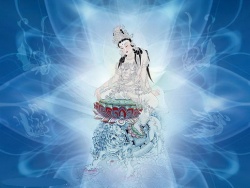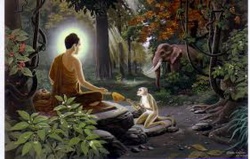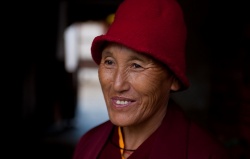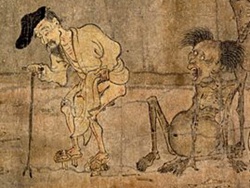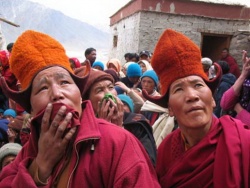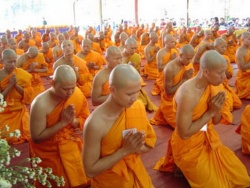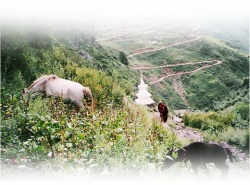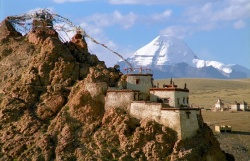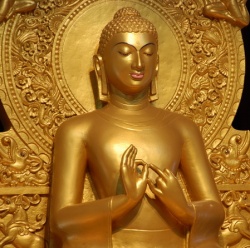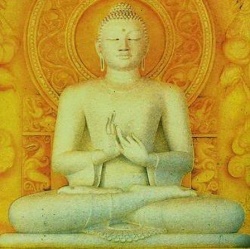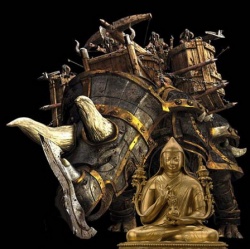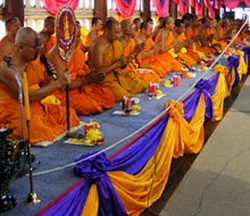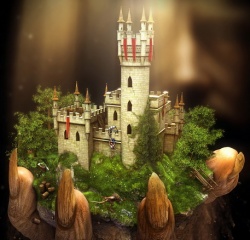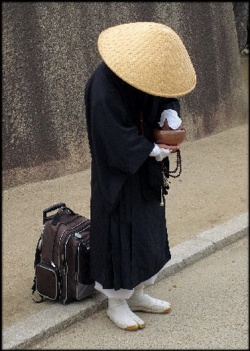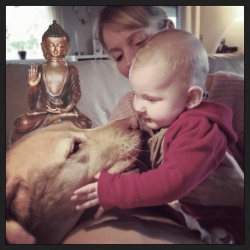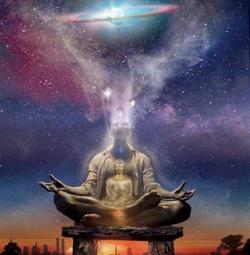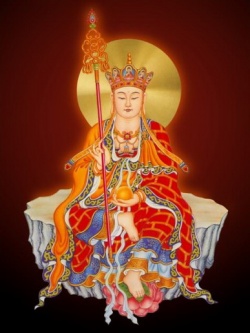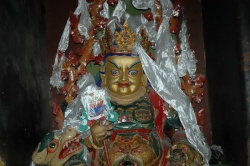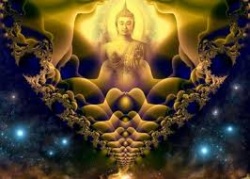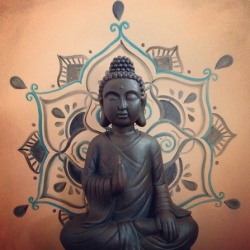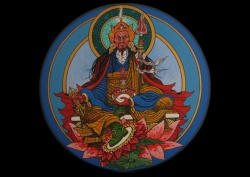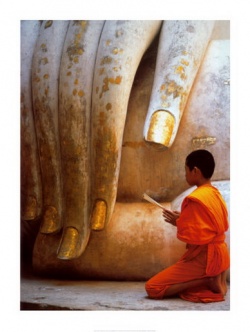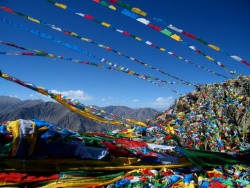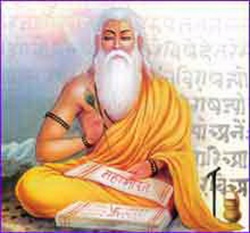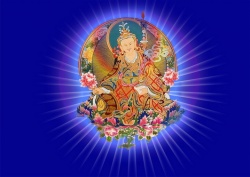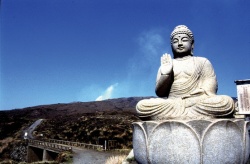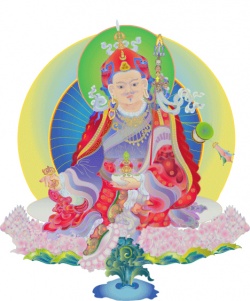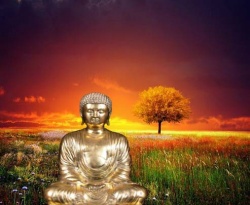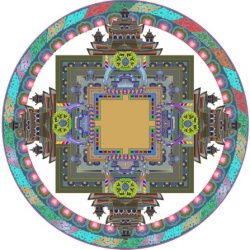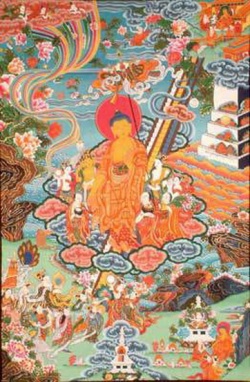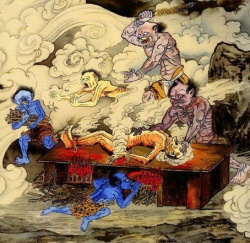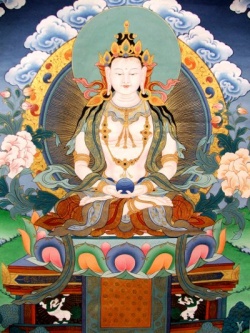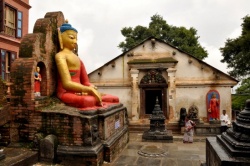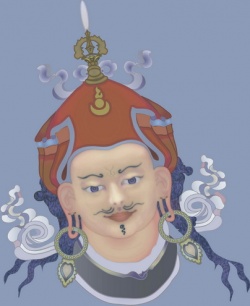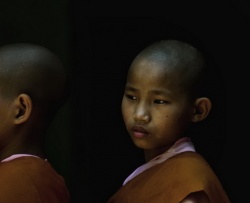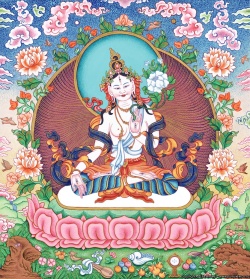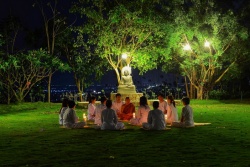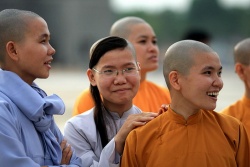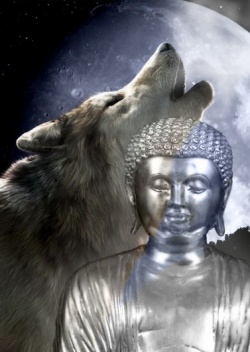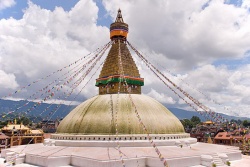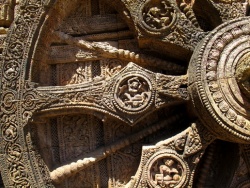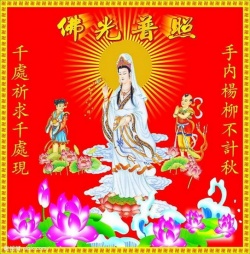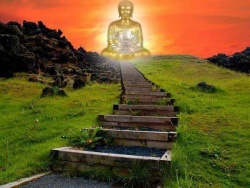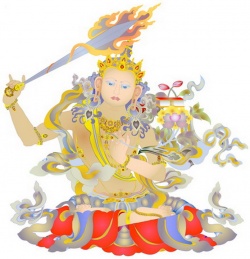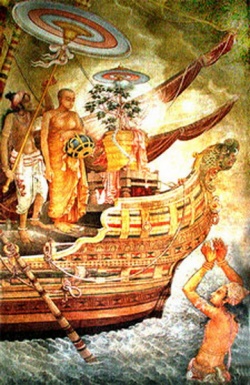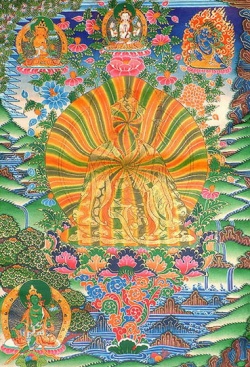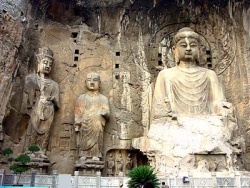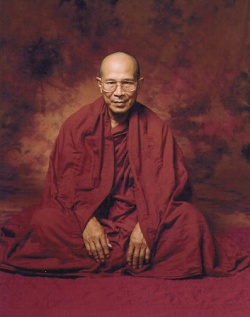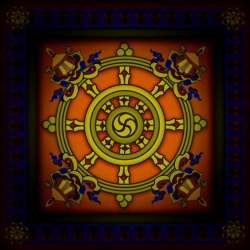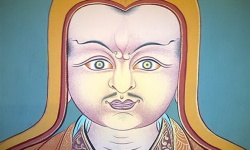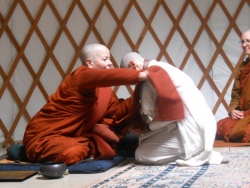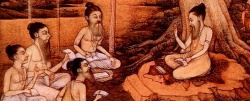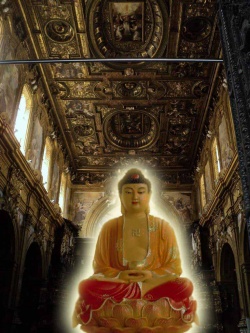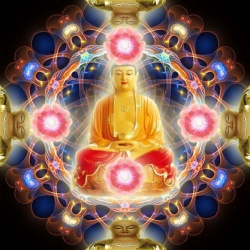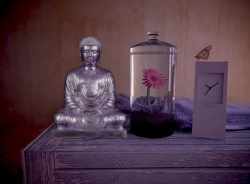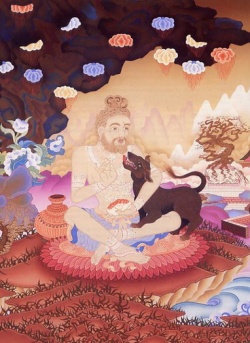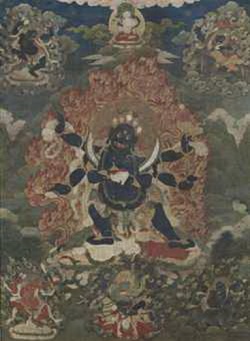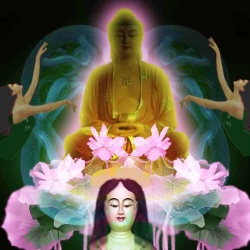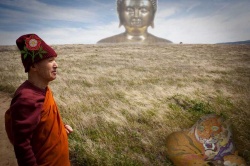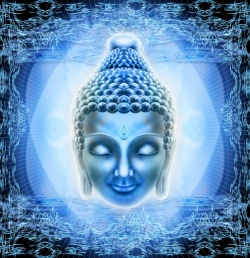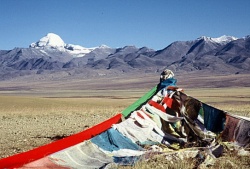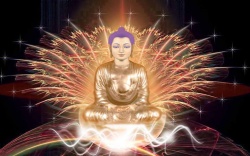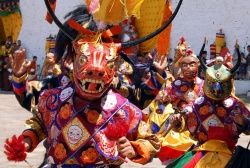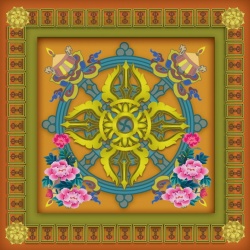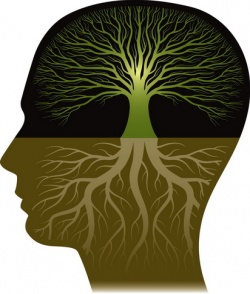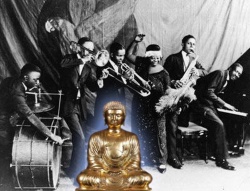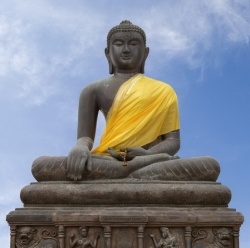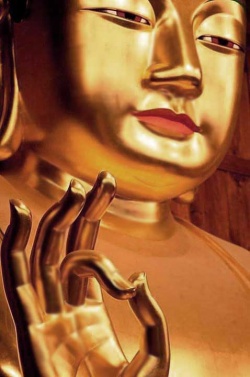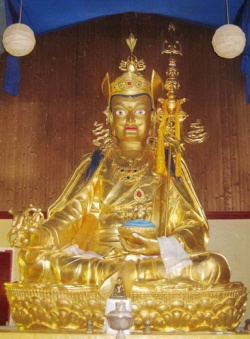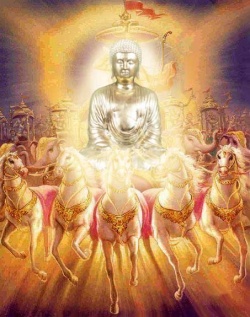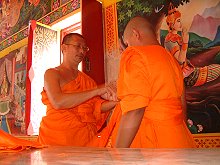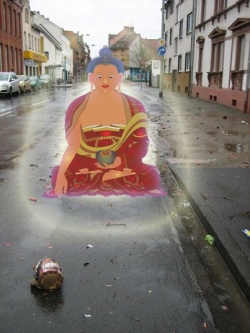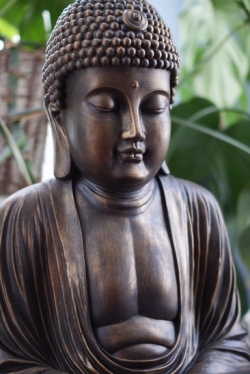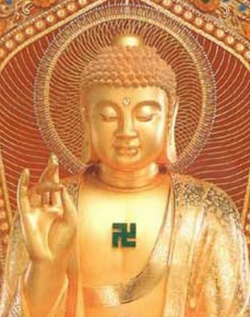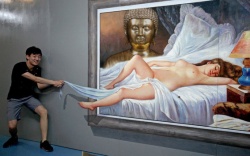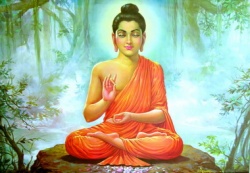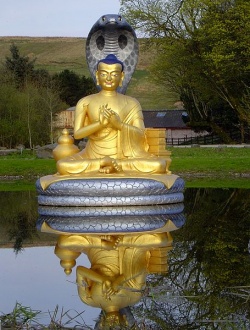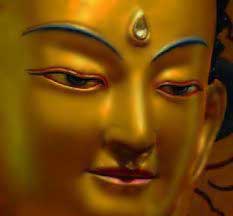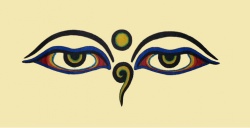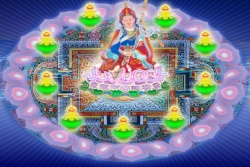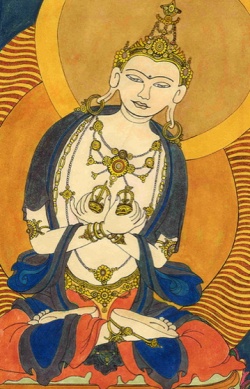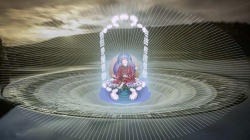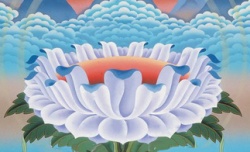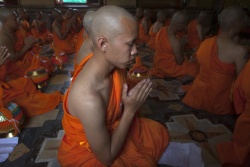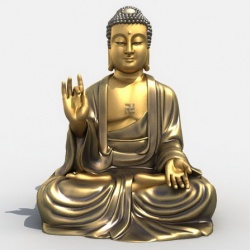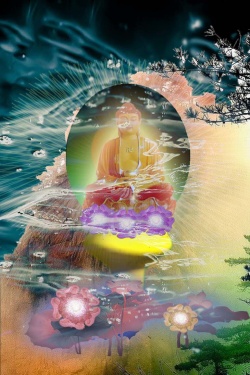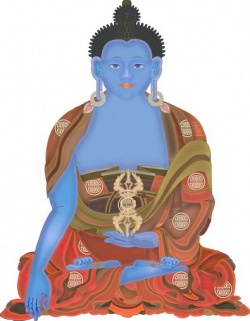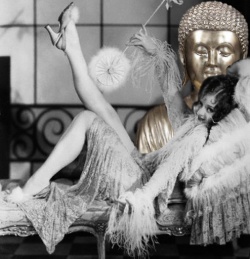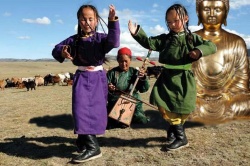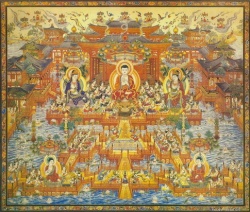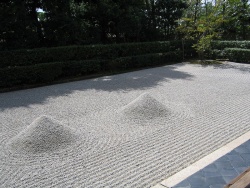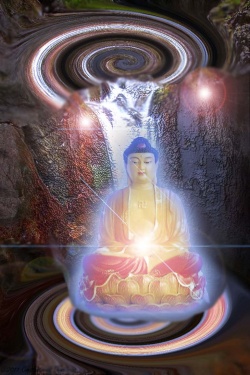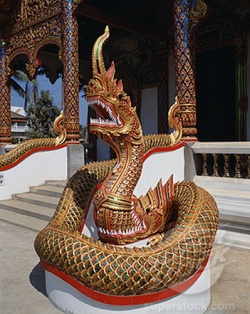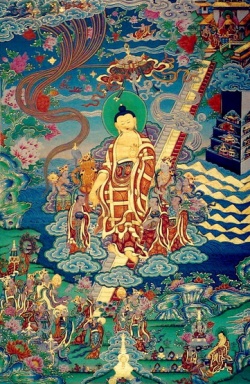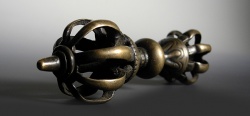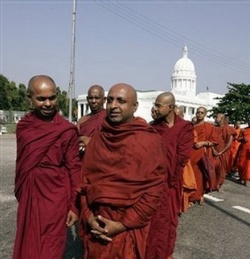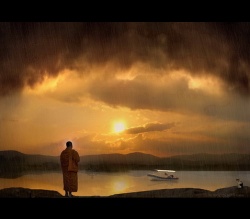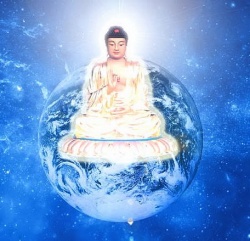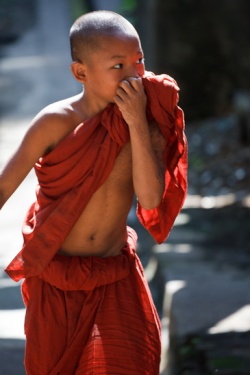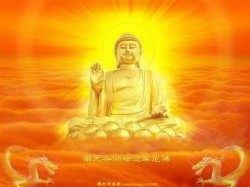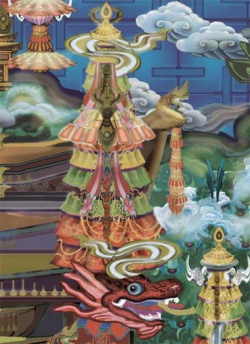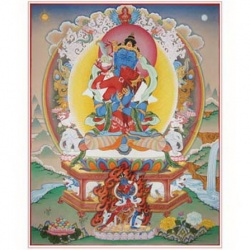A Torch for the Path to Omniscience
A Torch for the Path to Omniscience
A Word by Word Commentary on the Text of the Longchen Nyingtik Preliminary Practices
Empty in essence, expansive like space and free from the limits of conceptual elaboration, is the Dharmakāya.
With the nature of clarity, blazing brightly like the sun and ornamented with the signs and marks, is the Sambhogakāya.
The display of compassionate energy, manifesting in various ways out of compassion, is the Nirmāṇakāya.
At the feet of the Lama, inseparable from the three kāyas, I make heartfelt prostrations, my body, speech and mind filled with devotion. The rivers of the mind-direct, sign and aural transmissions, All come together and converge in Jigme Lingpa, His wisdom-mind treasure was the Heart-Essence of Nyingtik, And it is to the recited words of its preliminary practices, That I now compose this commentary.
Blessing the Speech
Firstly there is the blessing of the speech.
The syllables OṂ, ĀḤ HŪṂ are the essence of the enlightened body, speech and mind.
They purify obscurations of speech and bless your own ordinary body, speech and mind with the enlightened body, speech and mind.
Upon your tongue faculty is a bright syllable RAṂ, from which arises a fire, consuming all defilements and obscurations of speech.
The fire transforms into a three-spoked vajra of red light.
In its centre, or belly, are the vowel and consonant mantras, and around them is the Essence of Dependent Origination.
The syllables are like a string of pearls.
From them stream out five-coloured rays of light with countless offering substances at their tips, to the buddhas and bodhisattvas of the ten directions, thereby pleasing them.
Then as the rays of light converge back, the letters of the vowel and consonant mantra and the Essence of Dependent Origination descend like rain and dissolve into your speech chakra, purifying all your obscurations of speech.
And through this, all the blessings and siddhis of the vajra speech of the buddhas and bodhisattvas are obtained. If you recite the vowel and consonant mantras and the Essence of Dependent Origination seven times, or three times, at dawn before anything else, it is said that the power of your speech will be multiplied one hundred million times.
The Actual Ngöndro
1. The Ordinary Preliminaries
Within the actual preliminary practice, there are the ordinary (outer) and extraordinary (inner) preliminaries.
The ordinary oute preliminaries are reflections on: the difficulty of gaining the freedoms and endowments; death and impermanence; the karmic principles of cause and effect; the defects of saṃsāra; and how to follow a spiritual teacher.
a. The Difficulty of Gaining the Freedoms and Endowments
This first section consists of an invocation of the master’s wisdom mind, and recognition of the freedoms and endowments.
=Invocation of the Master’s Wisdom Mind
Firstly, as you recite “O lama, care for me!” three times, pray one- pointedly with an uncontrived faith that is vivid, eager and confident. Vivid faith comes from thinking of the qualities of the master and the Three Jewels.
It is a very vivid and joyful state similar to the way a small child feels when seeing its mother.
Eager faith is the eager wish to abandon negative actions having reflected on their faults; and the eager wish to undertake positive actions having considered the benefits they bring.
It is similar to the yearning that someone suffering from extreme thirst has for water.
Confident faith is a confidence in the qualities of the master and the Three Jewels, which cannot be shaken by temporary circumstances or events, and a trust in the laws of cause and effect strong enough to survive the worst kind of circumstances such as illness.
This is the kind of faith one should have.
If you don’t have this kind of faith, and you just mouth the words “O lama!” and call out, you won’t receive any blessings. It says in the sutras:
The pure Dharma will not arise in those without faith,
Just as fresh shoots will not grow from burnt seeds.
So, giving an example to illustrate this kind of faith, the text says, “The blossoming lotus of devotion at the centre of my heart.”
When you go to sleep at night, consider that the lama descends from the top of your head [to your heart) and then fall asleep with your mind indivisibly united with the master’s wisdom mind.
Then, as soon as you get up, early in the morning, recite, “O lama, care for me!” three times, with the three kinds of faith described above.
Like a lotus flower blossoming in the sunlight, the eight-petalled lotus at your heart unfurls its petals through the strength of your faith.
Pray to your only constant refuge in this life and the next, your lama, whose supreme compassion for you is such that he rises out of the state of great bliss and simplicity of the dharmakāya, in his ‘form body’.
Pray with these words: “Please look upon me with compassion! I have accumulated negative karma and harmful actions in the past, and now, as a result, I am plagued by turbulent emotions, which are so strong that I suffer terrible misfortune in my Dharma practice that hinders my progress on the path.
To protect me from the enemy of disturbing emotions, rise up through the central channel to the space above the chakra of great bliss at the crown of my head, upon a lotus, and sun and moon disc seats. Remain there as the jewel ornament and lord of my buddha family until I attain enlightenment, I pray!”
The method for guarding the mind from the disturbing emotions is described in the Bodhicaryāvatāra:
If, with the rope of mindfulness,
You bind firm the elephant of the mind,
You will let go of every fear,
And find virtue close at hand.
Your mind is like an elephant or a wild horse. The mindfulness of focusing on virtuous states of mind like faith, or devotion, is like a rope or a tethering post. And the awareness, which discerns whether or not mind remains in that virtuous state, is like a shepherd.
So, as a guard to ensure that you are never distracted from mindfulness and awareness, you invoke the lama, by praying: “Rise up out of compassion from the expanse of the dharmakāya, so that my mind does not become distracted from what is virtuous. And look upon me with your eyes of wisdom, I pray!”
Recognizing the Freedoms and Advantages
There are eight freedoms and ten advantages. Firstly, if you were born in the hell, preta or animal realms, you would suffer from intense heat and cold, from hunger and thirst, or from enslavement, and it would be impossible for you to practise the Dharma.
If you were born amongst the long-living gods, it would also be impossible because you would not have any thought of practising the Dharma.
The Buddha’s teachings are not found in uncivilized lands of the border regions, so living there is also an impossible state.
Those with wrong views do not have any possibility of practising the Dharma because their minds are contaminated by false beliefs, and they are just like Devadatta or Lekpe Karma.
If you were born in a world where a buddha had not come, or during a dark kalpa, it would be impossible because even the words ‘Three Jewels’ would be unknown.
If you were born incapable of understanding, it would be impossible to practise the Dharma because you would not be able to understand the meaning of the teachings.
When you have a physical body that is free from these 'eight states where there is no chance for Dharma practice', it is known as possessing a support for Dharma practice complete with the eight freedoms.
Secondly, the ten advantages are divided into the five personal advantages and the five circumstantial advantages. With regard to the first of these, being born as a human being means that you have a proper physical support for practising the Dharma.
Having all five faculties intact means you can study the teachings and contemplate them. In a central land means to be born in a place where the teachings are available.
A lifestyle that is not harmful or wrong means that your body, speech and mind are in harmony with the Dharma.
Having faith in Buddha’s teachings means recognizing that they provide a special path leading to freedom from saṃsāra, and a state which surpasses the situation of the worldly gods. When you possess these five endowments, 'the five personal advantages' are said to be complete.
For the five advantages due to circumstances to be present, a buddha must have come into the world, an event as rare as the appearance of an Uḍumbara flower; he must have taught the three wheels of Dharma; and the teachings must have survived without fading.
There must be extraordinary friends who have embraced the teachings;[1] and a master or a spiritual friend must have accepted you. These five are known as 'the five advantages due to circumstances'.
If you have every one of these eighteen freedoms and advantages then you have what is known as a ‘precious human life’, and you are in a position to practise the teachings that bring about permanent freedom from saṃsāra.
Nevertheless, if you succumb to negative influences and adopt an incorrect lifestyle and so on, then your human life will have gone to waste. As it is said:
Finding a human life with freedoms and advantages,
Is like finding a priceless jewel,
Just look how those without renunciation,
Waste this opportunity!
Or:
Used well, this body can be a ferry to liberation,
Used badly, it is an anchor in saṃsāra.
b. Meditating on Impermanence
There are many circumstances that cause death. It is possible to die from an attack of epilepsy, after becoming bed-ridden with a chronic terminal disease, from food poisoning, from falling from a precipice, or from being attacked with weapons.
It is uncertain when death will come. Life is as precarious as a candle fluttering in the wind, or a tiny bird perched on the branch of a tree.
There is no telling if, having gone to sleep at night, you will wake up the following morning. You are alive now, yet it is uncertain whether or not you will still be alive in a year’s time.
Having left this life behind, you will have to go on to yet another realm of existence. So pray: “O Guru Rinpoche, from this day forward, turn my mind towards the practice—care for me!
And see that my practice does not stray onto the wrong paths, such as practising merely to avert sicknesses and demons in this life or to gain food and clothing!
Keep me from falling into the inferior attitude of seeking liberation from saṃsāra for myself alone, leaving all my past mothers behind! Omniscient Master of Dharma Longchen Rabjam, you know me!
Compassionate root lama, you who are one with the Precious Master Guru Rinpoche, Longchen Rabjam, and Rigdzin Jigme Lingpa— care for me!”
If you do not seize the opportunity to practise the Dharma offered by this present situation, having obtained all the freedoms and advantages, then in future lives you will not find such a perfect physical basis for attaining liberation from saṃsāra.
That you have gained this happy existence now is a result of the slight merit you have accumulated in past lifetimes.
If you do not practise virtue in your present situation, and instead accumulate only harmful actions, then once the merit from past lives that provided this physical basis is spent, after death you will wander as a being in the lower realms.
Once you are born in such an unhappy state, you will not know good from bad, and you will never even hear the sound of Dharma. You will not meet a spiritual friend. You will be just like a blind person left alone in the middle of a vast desert. What a terrible disaster!
What a tragedy! Sentient beings in the hell realms are as numerous as atoms in the earth.
Hungry ghosts are as numerous as grains of sand on a riverbank. Animals are as numerous as grains in a barrel of chang.
If you think of the numbers and kinds of beings in the lower realms, you will realize just how slim is the chance of gaining a human body.
In comparison to other beings, humans are as numerous as the particles of dust on your fingernail.
And even among human beings, those people whose behaviour is harmful and contrary to the Dharma are like stars in the night sky, whereas those who really act according to the Dharma are as rare as stars in broad daylight. Reflecting on this, pray: “O Guru Rinpoche, turn my mind towards the practice—care for me!
Omniscient masters Longchenpa and Jigme Lingpa, keep me from straying onto the wrong paths! Compassionate lama, you who are one with them, care for me!”
Since practitioners of virtue are so scarce, to obtain a human body is like arriving at an island of jewels. To attain such a promising basis as this, complete with all the freedoms and endowments, and then use it only to amass negative deeds would be like a merchant landing on an island of precious jewels and then returning empty-handed.
With such a fickle and impetuous mind you will not have any foundation for attaining liberation from saṃsāra, and your body will only help you to create further suffering.
It is especially important not to fall prey to the eight incidental circumstances that make Dharma impossible or the eight impossible states where mind cuts us off from the Dharma. Firstly, to be misled by corrupting influences, which means meeting teachers who do not act according to the Dharma.
Then, despite your occasional desire to practise Dharma, you may be prevented from doing so by your conflicting emotions, when the five poisons are raging inside your mind, and you are swept away by their strength. Or whilst practising, negative karma may overtake you and ripen as negative circumstances.
If you don’t know how to integrate these into the path, then they will become obstacles. You may wish to put the teachings into practice, but if you lack diligence, you will be distracted by laziness. In some cases, you may have an interest in the teachings, whilst being a slave under someone else’s control.
There are also those who merely appear to be engaged in the path and just pretend to practise for the sake of gaining food and clothing, or as a cure for illness or harmful spirits, or out of fear of punishment.
This is like putting donkey meat into a container and passing it off as quality venison or camel meat. Although your attitude conflicts with the teachings, you act like a practitioner in the company of others in the hope of gaining some respect or reward.
Being chronically senseless and stupid means not feeling any enthusiasm when learning of the qualities and benefits of positive actions and not fearing the consequences of negative actions, having been influenced by negative friends.
These are 'the eight incidental circumstances that make Dharma impossible'.
Then there is the second set of eight. The first of these occurs when, even though you see and hear about the sufferings of saṃsāra, such as those in the three lower realms, you do not fear them, and therefore feel only slight disenchantment and little renunciation.
It is said that faith (or devotion) is like a precious wheel, which rolls along the path of virtue day and night.
And faith is the most important among the seven noble riches. Yet there is a state in which you lack the jewel of devotion for the teachings and for the master. There is also a state in which you are caught in the bonds of worldly ties and cravings for wealth, possessions and friends.
In another state, you might have a negative character just like black coal that cannot be made clean, and engage constantly in crude, degenerate behaviour, incurable like a poisonous snake.
Having never pacified your body, speech and mind, you may never hold back from negative, harmful actions that conflict with the teachings.
Or owing to your lack of even the slightest real interest, you may not have even a hint of a virtuous mind, just like an animal gazing at a temple.
You might be left with your prātimokṣa and bodhisattva vows all broken, or your samaya commitments of the secret mantrayāna torn to shreds through having disparaged the master and so on. These are 'the eight impossible states where mind cuts us off from the Dharma'.
Pray as follows: “When these sixteen impossible states come upon me, menacing my Dharma practice, O Guru Rinpoche, turn my mind towards the practice—care for me!
Omniscient masters, Longchenpa and Jigme Lingpa, keep me from straying onto the wrong paths! Compassionate lama, you who are one with them—care for me!”
You must rid yourself of such adverse circumstances because once you have fallen into any of these impossible states, you will not have the chance to practise Dharma purely and authentically.
At this present moment, your body is not ravaged by sickness, and your mind is free from pain, nor are you like a slave under someone else’s control.
So now that you have this perfect, auspicious quality of total independence, if you waste the freedom and advantages of this human life through your own indolence or laziness and distraction,
then there is no need to mention that you will be separated from your companions, possessions, relatives and loved ones when you die! Even this body you hold so dear, which is like the house of consciousness, will be carried out alone from its bed and taken to some desolate spot to be torn to pieces by foxes, vultures, dogs and so on.
When that happens, your consciousness will be swept through the bardo realm like a feather blown about in the wind and there will be nothing but terror in store for you.
So you should pray, “In order to protect me from these fears, from this day on, O Guru Rinpoche, turn my mind towards the Dharma—care for me! Omniscient masters, Longchenpa and Jigme Lingpa, keep me from straying onto the wrong paths! Compassionate lama, you who are on with them—care for me!”
In the sūtras it is said:
Those who are lazy and lack diligence,
May live for a hundred years.
But it would be just as well to live for a few days,
Having constant diligence.
And in The Precious Treasury of Essential Instructions ([[Mengak Rinpoche’i Dzö) it says:
Don’t give away this human body with its freedoms and endowments to the enemy of food and clothing,
Don’t give away this altruistic mind of bodhicitta to the enemy of lesser vehicles,
Don’t give away the jewel-like nature of mind to the enemy of delusion,
Don’t give away the two wish-fulfilling accumulations to the enemy of this present life,
Don’t give away the practice of compassion to the enemy of laziness,
And don’t give away the mind of fervent devotion to the enemy of wrong views!
This is exactly how you should practice.
c. Karma: Cause and Effect
The results of beneficial and harmful actions will follow me. This means the various individual experiences of pleasure and pain undergone by beings in the six classes occur purely as a result of their own positive and negative actions. As it says in the Sūtra of a Hundred Actions:
It is the variety of actions,
Which creates the variety of beings.
And in the Sūtra of Advice to the King (Rājāvavādaka Sūtra), it says:
When his time has come, even a king has to die,
And neither his friends nor his wealth can follow him.
So for us – wherever we stay, wherever we go –
Karma follows us like a shadow.
Although the results of our actions do not manifest immediately, they never go to waste. The Sūtra of a Hundred Actions says:
The actions of beings never go to waste,
Even in a hundred aeons.
They are accumulated, and, once the time comes,
The result will come to fruition.
Even tiny negative actions should be avoided. The Sūtra of the Wise and Foolish says:
Do not disregard small misdeeds, thinking they are harmless,
Because even tiny sparks of flame,
Can set fire to a mountain of hay.
Once, during the era of the Buddha Kaśyapa’s teachings, there was a monk called Shebu Kapila[2] who teased the other monks by calling them names such as ‘horse-head’. Altogether he called them by eighteen such names.
It is said that later, during the time of Buddha Śākyamuni, he was reborn as a fish-like sea monster with eighteen heads. It is also said that a monk who compared another monk to a monkey was reborn as a monkey for five hundred lifetimes. And there are countless other examples which could be mentioned.
The great Bodhisattva Śāntideva said:
If a single moment’s negativity,
Can lead to an aeon in the Avīci hell,
Then with all our harmful acts accumulated in saṃsāra without beginning,
What chance is there of going to the higher realms?
The Sūtra of the Wise and Foolish also states:
Do not disregard small positive acts either, thinking they are without benefit,
Because even tiny drops of water,
Will eventually fill a large container.
In the past when the King Māndhāta was a beggar, he threw a handful of peas to Buddha Kṣantiśaraṇa.
Four fell into the Buddha’s alms bowl and two struck his heart. As a result, he reigned as ruler over the four continents for eighty thousand years, then became ruler in the heaven of the Four Great Kings for eighty thousand years, and finally ruled the kingdom of Indra for half as long.
Then there was the beggar woman who offered a bowl of water to a śrāvaka disciple of Buddha Śākyamuni and was reborn in the heaven of the Thirty-three.
It is also said that if an animal hears the name of a buddha once, they will escape the lower realms and be reborn in the higher states of existence. The benefits of positive actions are inconceivable.
The Treasury of Essential Instructions says:
Listen to the words of the master, the most cherished instructions!
Study the words of the victorious one, and put your trust in them!
By day and by night, dedicate your virtue and limit your misdeeds!
Reflect on how the interdependence of cause and effect will determine your future!
Relinquish your attachment to the body and possessions you hold so dear!
And apply the points of the tantras, āgamas and upadeśas to your mind!
Take this to heart.
d. The Defects of Saṃsāra
Basically, wherever you are born within saṃsāra, whether it is in the higher realms or the lower ones, you will only ever be tormented by the three kinds of suffering.
In particular, if you are born in the hell realms as a result of the karma of accumulating harmful actions, in the eight hot hells the entire floor beneath your feet will be of burning iron.
In the first, the Reviving Hell, whatever you see turns into an enemy who attacks you with weapons. Your head and body are hacked to pieces, and you experience the suffering of dying and being revived time and again.
The life span of beings in this realm is described in the Application of Mindfulness Sūtra:
The beings of the Reviving Hell live for one hundred and sixty two thousand times ten million human years.
The life span doubles for each of the hells below this one.
In the Black-Line Hell multiple lines are drawn on your body which is then ripped apart with saws. In the Crushing Hell countless beings are wedged in mortars of iron the size of whole valleys and crushed with red-hot hammers.
In the Howling Hell you are trapped in a doorless cell of burning iron and worn out with suffering and pain.
In the Great Howling Hell you are trapped in an iron cell like before, but with double walls, and you scream out loud ly in agony as you are beaten with hammers and other weapons.
In the Heating Hell you are impaled on red-hot spikes and tridents, and wrapped in strips of heated iron.
In the Intense Heating Hell you are boiled in great vats of molten bronze.
Whenever your head is struck with a hammer you lose consciousness and in that instant you may experience a slight feeling a relief, but otherwise you experience nothing but suffering and pain.
The life span of beings there is impossible to count in years.
In saṃsāra, there are twenty intermediate kalpas for each of the periods of formation, subsistence, destruction and void.
The beings in the Intense Heating Hell live for half of one of these intermediate kalpas.
In the Avīci Hell of Ultimate Torment you are burned in a fire of the most intense heat, greater than that in the other seven hot hells.
The bodies of beings there are indistinguishable from the flames and can only be perceived by the sound of their agonized screams.
Weapons fall from the sky and hell-workers torture you with weapons causing you pain seven times more intense than that experienced in the earlier hells. In this one of the eight Hot Hells, the life span is one intermediate kalpa.
All the eight cold hells are surrounded by snow mountains, which are completely frozen at their base.
There, in the dark, on terrifying precipices of ice engulfed by squalls and blizzards of snow, your tender naked body is lashed by freezing cold winds.
You break out in blisters, which burst open into festering sores. You let out a ceaseless wail of agonized screams in the Hell of Lamentations.
And in the Hell of Groans, you experience suffering hard to even think about, like a dying person whose strength is all gone, and let out deep gasps and groans. You grind your teeth and clench them together in the intense cold.
Your flesh turns blue and the skin cracks open into four pieces like a blue lotus, and then the red raw flesh that is exposed cracks further into eight pieces like a red lotus.
Finally it turns an even darker red and splits even deeper into sixteen, thirty-two and then innumerable pieces like a great red lotus. Worms with metal beaks penetrate the cracked flesh and start to eat away at your insides.
These eight different sufferings are called the Eight Cold Hells.
The life span of beings in the Hell of Blisters is equal to the time it would take to empty a container capable of holding two hundred kośalā measures filled with sesame seeds, if you removed a single grain every hundred years. For the other cold hells, the life span and sufferings increase by multiples of twenty for each one.
Similarly, in each of the four directions surrounding the Hell of Ultimate Torment, there are four neighbouring hells, such as the 'Plain of Razor Blades'.
When the karma that led you there is exhausted, you leave the Avīci Hell and see an attractive plain. You walk towards it, but when you reach it, it turns into a plain of weapons, cut ting your feet to ribbons.
Similarly, you see what appears to be a pleasant forest, but once you arrive there it becomes a 'Forest of Sword Blades' where your body is gashed and chopped. Then you see a river and go towards it to have a drink, but it transforms into a 'Swamp of Putrefying Corpses'.
You become submerged in it up to your head and worms with metal beaks eat away at your flesh. Alternatively, you may see a shady trench, but once you arrive there it changes into a 'Pit of Hot Embers' and sinking inside it, you suffer as your flesh and bones are burnt away.
These are the sixteen Neighbouring Hells that ring the Hell of Ultimate Torment.
The Ephemeral Hells are changing, in the sense that their location is not fixed and the degree of pain experienced there is also uncertain. You suffer through taking birth in a door, pillar, fireplace, rope and so on—in a mortar, a broom, or a pot.
You suffer as you are trapped inside a stone, crushed between rocks, burned in a fire, boiled alive, or cut limb from limb as a piece of wood is cut. These are the 'Ephemeral Hells' in which you are always made use of and exploited.
The cause of being born in any of these eighteen hells could be a vast accumulation of harmful actions perpetrated out of desire or delusion.
Even so, a single momentary act such as taking life or speaking harsh words to an exceptional being, when carried out with a mind of intense anger, will propel you straight to the hells. As it is said in the Bodhicaryāvatāra:
If a single moment’s negative action,
Can lead to an aeon in the Avīci hell,
Then with all our harmful acts accumulated in saṃsāra without beginning,
What chance is there of going to higher realms?
Pray with the words of the text, “Whenever intense hatred and aggression arises, O Guru Rinpoche, turn my mind towards the practice—care for me! Omniscient masters Longchenpa and Jigme Lingpa, keep me from straying onto the wrong paths! Compassionate lama, you who are one with them—care for me!”
It is essential to give up your conflicting emotions. The Letter to a Friend states:
Having heard of these boundless sufferings,
Only someone with a mind as hard as a diamond
Would remain unaffected and unafraid.
And if just seeing pictures, hearing descriptions,
Or reading and thinking about the hells brings you such terror,
What will you do when you actually experience there
The full, inexorable effects of your actions?
Likewise, with sufferings similar to those of the hells, the preta realm is destitute of food and drink, creating hunger and thirst. It is a grim place of rocks and charred tree stumps, where the words 'food', 'drink' or 'comfort' have never even been heard.
In the past, Śroṇa travelled to the preta realm and, growing thirsty, he asked the beings there where he could find some water.
They replied that although they were born there twelve years previously this was the first time they had heard mention of water.
Since these pretas do not find anything to eat or drink for months and years on end, their bodies are emaciated like skeletons and they lack even the strength to stand. There are three different kinds of suffering they experience.
Firstly, those with external obscurations will go for many months and years without even hearing any mention of food or water. Then, from time to time, they might see a stream or some fruit trees far away in the distance.
With weak limbs and aching joints they struggle to get there, but as they approach they find that the water has all dried up or the trees have withered away. Or else the water and trees are still there, but they are guarded by beings who carry weapons, which they use to beat the pretas and cause them pain.[3]
The pretas with specific obscurations undergo sufferings such as having many creatures living on their bodies devouring them.
The life span for beings in this realm is about fifteen thousand human years.
There are many reasons for being born as a hungry ghost, such as eating in the afternoon after taking the vows of a one-day fast, but the principal cause is being miserly or greedy for wealth and possessions.
Animals living in the wild are in constant dread of being eaten by one another or killed by hunters. Domestic animals are exploited and worked until exhaustion, forced to pull ploughs or carry heavy loads.
Even when sores break out on their backs they are just given more to carry. They are made to carry people on their backs and they are often killed.
Bewildered as to what to do or not to do, they have no idea how to practise virtue and only amass negative actions, so they are oppressed by limitless suffering and lack any means of escaping from saṃsāra.
The seed or cause for being born in such a state is wandering into the darkness of stubborn stupidity, and thereby failing to undertake virtue and refrain from non-virtue.
So pray as follows, “From this day forwards, O Guru Rinpoche, turn my mind towards the practice—care for me! Omniscient masters, Longchenpa and Jigme Lingpa, keep me from straying onto the wrong paths! Compassionate lama, you who are one with them—care for me!”
Therefore we must practise virtue and give up negative actions.
Even in the higher realms of the gods and human beings there is no real happiness.
As the Application of Mindfulness Sūtra says:
There is never any joy in saṃsāra,
Not even the tip of a needle’s worth.
And the Lord Maitreya said:
There is no joy among the five classes of beings,
Just as there can be no pleasant fragrance in a cesspit.
As humans we face the three fundamental sufferings, the four great rivers of suffering of birth, ageing, sickness and death, the sufferings caused by fear of encountering hated enemies, or parting from loved ones, and the sufferings of facing situations we do not want, or not getting what we do want.
The asuras or demi-gods suffer from wars and strife. The gods face the suffering of death and transmigration, and the suffering of falling into the lower realms.
So, no matter where we might take birth, among any of the six classes of beings, there is nowhere that is beyond the nature of suffering.
As the Treasury of Essential Instructions says:
Our cherished homes and countries are like the iron cells of hell,
Wives and children are like the forest of sword blades,
Decorations and fine clothes are like the fiery tongues of flame,
Food and drink are burning lumps of metal,
And servants and workers the guardians of hell,
Angry quarrels are like a hail of glowing embers—
Understand that they all bring virtue and goodness to ruin.
e. How to Follow a Spiritual Friend
Having entered the path of the Dharma, and taken the outer vows of the prātimokṣa -Skt.—the vows of an upāsaka/upāsikā -Skt. (‘lay practitioner’), novice or a fully ordained monk or nun—you still haven’t put a stop to your erring ways and transgress the four root and various branch vows.
You have entered the door of the Mahayana, aroused the bodhicitta motivation of wishing to attain buddhahood for the benefit of all sentient beings and taken the vows of the bodhicitta of aspiration and application.
But you simply repeat phrases like, “May all beings have happiness!” and so on, whilst lacking any beneficial thought for others, and with an attitude that is malicious and deceitful.
Having embarked upon the path of secret mantra, and received the vase empowerment you are required to practice kyérim [Tib.], or the ‘development phase’. Having received the secret empowerment, you should practice mantra recitation;
having received the crystal empowerment, you should meditate on dzogrim [Tib.] (‘the completion phase’); and having received the fourth empowerment, you should meditate on the meaning of shunyata.
Though you have received these four empowerments many times you do not even do the slightest practice of the development and completion phases of meditation.
Considering how you have strayed onto wrong paths, pray with the words, “O lama, free me from these false paths!” This is a prayer to avoid falling under the influence of your conflicting emotions.
Through relying upon a qualified master you should maintain the precepts of the prātimokṣa, the bodhisattva vows, and the commitments of secret mantra, as they are described in their respective texts.
Then, through the coming together of the master’s blessing and your own faith and diligence, like a hook passing through a ring, you will be liberated from saṃsāra, crossing over to its far shore.
Apart from that, there is not some other method whereby the lama just releases you from saṃsāra, without your having to undertake positive actions and abandon negative actions, like a passenger carried along in a ferry or someone ‘liberated’ by being killed with a weapon.
If this were the case, then since the buddhas love all sentient beings equally as their very own children, they would liberate all limitless beings in an instant, without leaving a single one behind in saṃsāra.
There was not the slightest hair’s breadth of a difference between the love Buddha Śākyamuni felt for Devadatta and the love he felt for Rāhula. If his compassion and blessings alone could have liberated them, it would have been impossible for Devadatta to fall into the hells.
So it is very important that you take the words of the Buddha and your master to heart and put them into practice just as they have taught. As our Teacher said:
I have shown you the path to liberation.
But liberation depends on you alone.
So practise with diligence!
And Śāntideva said:
Countless buddhas, working for beings’ benefit,
Have already come and gone;
Yet on account of my faults,
I have not been an object of their healing,
And if I continue on this course,
Again and again, it will be the same.
Although you have not realized the view of shunyata, you act recklessly as if you were ‘a master of crazy wisdom’ and disregard the law of cause and effect.
Though you are distracted in your meditation and lack the qualities described in the scriptures, you allow yourself to remain stuck in concepts, and proudly refuse to follow a qualified teacher.
If you were really putting your heart into the practice, your body, speech, and mind would be in complete harmony with the teachings, as was the case with Glorious Atiśa and Geshé Ben.
Each time they had a negative thought, they would drop it immediately, and get down from their horse to perform a mandala offering. This is how you should be.
But instead of this, even though your mind is filled with disturbing emotions and the actions of your body and speech are at fault, you ignore your own shortcomings and dwell on the imperfections of others.
This is like having a ghost at your eastern door and performing the ransom ritual of lü at the door in the west.
Having an intellectual understanding of the difference between beneficial and harmful actions and then acting in a way that contradicts the teachings is a sign that you are Dharma-stubborn, like the hide of a butter bag, which is made tough by constantly being in contact with grease.
Pray that the lama may free you from your stubbornness and non-Dharmic behaviour and then practise according to the teachings.
Although you suffer from sickness and could die tomorrow, you are full of craving for and attachment to houses, clothes, and possessions.
Although your youth has passed and you are quite old, you do not have the slightest disenchantment or renunciation for saṃsāra.
Although you possess only the slightest wisdom gained through study, reflection and meditation, like the frog who lived in the well, you pride yourself on all your knowledge.
This arrogance comes from falling under the power of delusion, so pray that the lama will free you from such ignorance, and then abandon your attachment to saṃsāra and your pride in your own qualities.
The time of your death is uncertain and, like a candle in the breeze or a little bird on the branch of a tree, you are surrounded by potentially dangerous circumstances.
Yet still you forget about death and busy yourself with the affairs of this life, such as taking part in local rituals.
With a mind that is distracted, you may physically remain in solitary retreats, but all the while your basic character remains as tough as a block of wood.
To remain calm like a jackal in the woods, without having uprooted your disturbing emotions, speaking softly, while attachment and aversion boil inside your mind, is like the behaviour of a crane or a cat.
All of this is a sign that you are under the influence of the eight worldly obsessions: gain brings you happiness, and loss makes you suffer; you are happy to receive praise, but blame makes you angry; fame makes you happy, and insignificance saddens you;
and you are joyful in happiness, but despair when you suffer. Pray with the words, “O lama, free me from these eight worldly concerns!”
You should not allow yourself to become too preoccupied with concerns such as happiness and suffering, but view them all equally—in one taste—and integrate them into your practice.
This is achieved firstly by recognizing that the one who is happy when praised and becomes sad when blamed is essentially empty. Both are equally illusory, dream-like, and lacking in true reality. Secondly, it is said:
When you are happy, dedicate it as a gathering of virtue:
May all of space be filled with benefit and happiness!
Whenever you experience happiness by gaining wealth or renown, or new clothes, or eating a delicious meal, instead of holding onto that pleasure as your own, train your mind by dedicating it.
Think to yourself, “May all sentient beings, especially the hungry ghosts, the poor and the homeless, all enjoy this kind of happiness and pleasure!”
When suffering befalls you, such as when, for example, you hear something unpleasant or are afflicted by illness, it is said:
When you suffer, take on the sufferings of all,
May the ocean of suffering dry up completely!
Train your mind by thinking to yourself, “In addition to my own sufferings, may I take on the sufferings of all beings and may they enjoy happiness and well-being!”
Pray in the following way: “Quickly rouse me from this deep sleep of ignorance, in which I am like an animal who does not understand the difference between positive and negative actions!” And pray that you may be inspired by a healthy fear of causing harm and an enthusiasm for beneficial actions.
Throughout the course of your lifetimes without beginning, up until the present, you have not known how to practise the Dharma as a way of gaining freedom from saṃsāra.
Instead, you continue to languish in saṃsāra’s prison. Pray that you may develop a genuine heart of sadness and renunciation and be quickly freed from the dismal imprisonment within saṃsāra, thereby attaining the state of liberation and omniscience. Take this to heart.
The Treasury of Essential Instructions says:
One birth is sufficient: cut the ties of attachment today!
One accumulation is sufficient: see the master as the Buddha!
One action is sufficient: accomplish the Lama Buddha!
One training is sufficient: abandon non-Dharmic actions!
One recognition is sufficient: recognize the dharmatā!
One practice is sufficient: abide by that very state of reality!
2. The Extraordinary Preliminaries
There are six sections to the extraordinary preliminaries.
. Taking Refuge
The first of these sections is taking refuge, which is explained in terms of the divisions of refuge, the way to take refuge, and finally the benefits and precepts of refuge.
i. The Divisions of Refuge
Generally, it is said that refuge is the foundation stone of all Dharma practices, and that which opens the door to refuge is faith. The importance of the three types of faith has already been shown above. It may be further demonstrated by the stories of Ben of Kongpo and the old lady and the dog’s tooth.
ii. The Way to Take Refuge
As for the method of taking refuge, the field of merit should be visualized according to the descriptions in the various commentaries. Then:
The Buddha, Dharma and Saṅgha are supreme among all that is rare, like a priceless jewel. They constitute the outer refuge. The real essence or embodiment of these three is the Sugata, the Buddha, as it says in the Sublime Continuum (Gyü Lama):
The single refuge is the Buddha.
The three roots are the lama, yidam and khandro, the inner refuge of the secret mantrayāna.
They are like the root or the basis for all the positive accumulations until you attain enlightenment.
Taking refuge in order to use the channels as the nirmāṇakāya, train the inner air as the sambhogakāya, and purify the tiklés—whose nature is the bodhicitta—as the dharmakāya is the secret refuge.
The ultimate refuge is the primordial wisdom present within the wisdom mind of these objects of refuge—the mandala of the empty essence, the cognizant nature and the all-pervading compassionate energy.
In order to accomplish this within our own mind-stream we take refuge until enlightenment is fully realized.
With this in mind we take the vow of refuge.
Precepts and Benefits of Taking Refuge
As regards the precepts and benefits of taking refuge, in terms of precepts there are three things to be abandoned, three things to be adopted and three supplementary precepts.
Firstly, having taken refuge in the Buddha, do not take worldly deities such as local spirits as your outer refuge and do not make offerings to them. Having taken refuge in the Dharma, refrain from harming other beings.
Having taken refuge in the Saṅgha, do not associate with non-buddhist extremists (tīrthikas), or anyone whose behaviour is contrary to the teachings.
Regarding the three things to be adopted, having taken refuge in the Buddha, you should honour and respect any representation of his body, even a tiny piece of broken statue.
Having taken refuge in the Dharma, you should respect and take care to preserve the written teachings, even fragments of paper bearing a single syllable.
In the past, when Lord Atiśa saw a scribe putting his pen in his mouth as he wrote, he cried out, “Atsama!
That’s not right!” Having taken refuge in the Saṅgha, even a patch of red or yellow cloth from their robes should inspire you with faith.
As supplementary precepts, rely upon your spiritual master and practise without doing anything that violates or conflicts with his body, speech or mind. Listen to the teachings and follow the Dharma and the Saṅgha.
It says in the Pig’s Story (Pak Gi Tokjö):
Whoever takes refuge in the Buddha
Will no longer be reborn in the lower realms.
Forsaking even the body of a human being,
They will be reborn among the gods.
And the Parinirvāṇa Sūtra says:
Whoever takes refuge in the Three (Jewels)
Will swiftly attain enlightenment.
b. Arousing Bodhicitta
There are three sections: training the mind in the four immeasurables; arousing bodhicitta, the mind turned towards supreme enlightenment; and training in the precepts of bodhicitta in aspiration and bodhicitta in application.
Training the Mind in the Four Immeasurables
Ho is an expression of compassion. The objects of compassion are the beings of the three realms and six classes. They are mesmerized by the variety of perceptions, apprehending an ‘I’ where there is no ‘I’, and a self where there is no self.
These misperceptions are said to be like seeing a pile of stones from a distance and mistaking it for a person, or perceiving a coloured rope as a snake, or thinking, like a small child, that the illusory (not truly existent) reflection of the moon which appears in water is the real moon.
Cultivate compassion for beings by considering their miserable situation: all of them—throughout the three realms and six classes—grasp at their deluded perceptions, imagining them to be real, and wander endlessly in saṃsāra without finding any escape, like the turning of a wheel, or a rosary.
All beings, as limitless in number as space is vast, are our very own mothers and fathers who have shown us exactly the same kindness as our parents in our present lifetime.
So that these parents of ours may remain no longer in their pitiful state, and instead attain enlightenment, finding comfort and ease in the luminosity and all-pervading space of the true nature of their minds, we should train our minds by means of the four immeasurables.
1. Equanimity
Initially, we need to train the mind in equanimity. The way in which we are currently attached to our friends and aggressive towards our enemies is a fault which comes from failing to examine the situation thoroughly. In reality, today’s so-called ‘enemies’ have, in the course of our many past lifetimes, been dear friends who have helped us enormously. And those whom we currently consider to be our ‘friends’ have been our enemies in past lifetimes, having caused us considerable harm.
He eats his father’s flesh, while striking his own mother,
And cradles in his lap the enemy he killed;
The wife is gnawing at her husband’s bones.
saṃsāra is enough to make you laugh out loud!
Recognize that this bias, which currently causes us to see some people as our friends and others as our enemies, is a result of having fallen under the power of ignorance. Train your mind until you feel a benevolent attitude, like the one you have now for your present mother and father, for all beings, especially your ‘enemies’ and those who create obstacles for you.
2. Love
Then, since these beings have shown you exactly the same kindness as your current parents, cultivate love for them all and wish them happiness in order to repay their past kindness.
Train yourself to be like parents caring for a small child, or a mother bird looking after her young, so that all your actions of body, speech and mind are undertaken only to ensure the happiness and well-being of others.
3. Compassion
Cultivate compassion, which is the wish for beings to be freed from suffering. Imagine a prisoner who is about to be executed, or an animal at the slaughterhouse, and put yourself in their position, or imagine that they are your own dear mother.
When you experience an unbearably intense feeling of compassion for them, consider that although the one experiencing such suffering is not actually your mother or father in this lifetime, he or she has been your mother and father countless times throughout the course of your innumerable lifetimes.
Practise cultivating this compassion until you feel exactly the same compassion for all sentient beings as you do for your own mother and father.
4. Joy
Whenever you see someone who is wealthy and powerful, and apparently enjoying all the pleasures of the higher realms, or whenever you see someone who possesses the qualities of scriptural learning and realization, do not feel resentful or envious of them, even if you consider them to be an enemy. Instead, feel joyful and make the wish that their riches and power increase even further.
And pray that all sentient beings may experience the same kind of good fortune. Train your mind in this way, again and again.
If, when you practise training the mind in these four immeasurables, you proceed gradually— first considering your own parents; then including your friends and relatives; and finally extending the practice to your enemies—you will come to feel the same love and compassion for your enemies as for your parents. This is the measure of your mind training.
ii. Arousing Bodhicitta
As for the actual practice of arousing bodhicitta, whilst in a state that is mindful and aware of these points of training the mind in the four immeasurables, visualize the field of merit in front of you—just as you did in the refuge practice—which then becomes the witness to your arousing of bodhicitta.
The bodhicitta of wishing to attain enlightenment for the benefit of all sentient beings is pledging yourself to the goal. This is the bodhicitta of aspiration, which is like making a wish to go to Lhasa, for example.
Vowing that until you attain enlightenment you will practise the six perfections, such as generosity, and strive with effort until saṃsāra is completely empty, is pledging yourself to the cause. This is the bodhicitta of application, which is like making the actual journey to Lhasa up until your eventual arrival there.
The Bodhicaryāvatāra says:
Understand that, briefly put,
bodhicitta has two aspects.
Just as one would know the difference
Between wishing to go and going on a journey,
The wise should understand these two,
Recognizing their difference and their order.
Once you have taken the vows of the bodhicitta of aspiration and application, whilst being mindfully aware of the words of the practice and their meaning, the field of merit melts into light and dissolves into you.
Consider that all the two-fold bodhicitta present within the wisdom minds of the deities arises within your own mind-stream. And then rest in the state of indivisible emptiness and compassion.
Training in the Bodhicitta Precepts
Thirdly, there is training in the bodhicitta precepts. This includes, in the context of the bodhicitta of aspiration, meditations on equalizing self and others, exchanging self and others, and considering others as more important than yourself. And for the bodhicitta of application there is the practice of the six perfections.
1. Precepts of the bodhicitta of Aspiration
Firstly, since all beings are equal in that they want happiness and wish to avoid suffering, we should abandon the attitude of attachment and aversion which causes us to cherish ourselves and feel aggressive towards others. Train in the practice so that you view yourself and other beings as equals.
Secondly, the way to meditate on exchanging self and others is to practise giving happiness and receiving suffering as you breathe in and out (the practice of tonglen).
No matter what unwanted suffering comes your way, focus on wishing to take on the suffering of others as well. Train your mind in this practice, which is illustrated by the story of Daughter, and the Buddha pulling a wagon in the hell realm.[4]
When you train your mind in considering others as more important than yourself, cultivate the willingness to take birth even in the hells should it be of benefit to other beings.
This is illustrated by the stories of Atiśa’s teachers Maitrīyogi and Dharmarakṣita; the bodhisattva Metok Dadze; and the Buddha in his earlier rebirths.
2. Precepts of the Bodhicitta of Application
Then, the training in the precepts of the bodhicitta of application, which is training in the six pāramitās, or the six perfections.
The first of these, generosity, is divided into material giving, giving the Dharma, and giving protection from fear. You should practise these three kinds of generosity according to your capacity.
At the very least, you should offer Sur (burnt offerings) and water tormas, since this offering incorporates all three kinds of giving.
Discipline is divided into the discipline of avoiding negative actions, the discipline of undertaking positive actions, and the discipline of bringing benefit to beings.
The first kind of discipline means that you give up even the slightest unwholesome deed of body, speech or mind.
The second means that you strive to practise virtue as much as you possibly can, beginning with the tiniest of positive acts. Be sure to embrace these acts with the proper preparation, main part and conclusion.
Thirdly, bringing benefit to beings means working for the welfare of others through the four ways of attracting disciples,[5] once the time has come for you to do so, and when you are free from any selfish motivation.
For beginners, it is most important to train the mind in the first two types of discipline with the bodhicitta motivation of wishing to benefit others.
Patience consists of being patient when wronged; the patience to bear hardships for the Dharma; and the patience to bear the profound truth without fear.
Diligence is divided into armour-like diligence; diligence in action, which means exerting yourself to practice the Dharma and fearing laziness with as much energy as someone who discovers a poisonous snake in his or her lap; and insatiable diligence.
Insatiable diligence is never being satisfied by a little, or a few months, or even a few years of virtuous practice, and instead exerting yourself to practise throughout your entire life.
Meditative concentration includes the childish concentration of those who practise in isolation away from distractions and busyness, but are attached to the experiences of bliss, clarity and absence of thought.
There is also the clearly discerning concentration in which emptiness is clung to as an antidote; and the concept-free samādhi of intrinsic reality, which is known as 'the concentration delighting the Tathāgatas'. These should be practised successively, in stages.
Sixth, is the pāramitā of wisdom.
Through the wisdom that comes from hearing, you are able to recognize the disturbing emotions.
Then, through the wisdom that comes from reflection, you are able to overcome the disturbing emotions temporarily.
And finally, through the wisdom that comes through meditation, you conquer completely the enemy of negative emotions and obtain the confidence of knowing inexpressible and inconceivable reality with the wisdom of discriminating awareness.
If you fail to arouse this altruistic attitude of bodhicitta in your mind, then, however much you might act virtuously and avoid negativity for your own sake, you will not become enlightened.
The Bodhicaryāvatāra says:
What need is there to say more?
The childish work for their own benefit,
The buddhas work for the benefit of others.
Just look at the difference between them.
c. Meditation and Recitation of Vajrasattva
In the practice of Vajrasattva, the four powers must be complete.
The first of the four powers is the power of support. ĀḤ signifies the unborn nature.
Reflect on how all phenomena included within your ordinary dualistic perception are empty, devoid of self and sky-like.
From that state, the essence of which is clear and spacious, generate compassion for all those who have not realized this themselves.
And then, with the wish to attain enlightenment for the benefit of all beings, visualize yourself in your ordinary form.
Consider that about eighteen inches above your head is a white lotus.
If you are following the extensive commentary (Kunzang Lama’i Shelung) the lotus has a thousand petals, whereas according to the briefer commentary [by Jamyang Khyentse Wangpo) it has eight petals.
Upon it, in the centre of a full moon-disc seat, is a white syllable HŪṂ, which melts into light and becomes your own root lama in the form of Vajrasattva.
He is brilliant white, with complete sambhogakāya adornments.
He is ornamented with all thirteen adornments: the five silk adornments of the headscarf, upper garment, long scarf, belt and lower garment; and the eight jewelled ornaments of the crown, earrings, short necklace, armlets, two long necklaces (one longer than the other), bracelets, anklets and rings.
His legs are crossed in the vajra posture. His right hand holds a vajra at his heart, and his left holds a bell against his hip.
The consort white Vajratopa (Dorje Nyemma) has her legs crossed in the lotus posture, and is embracing Vajrasattva.
Consider that their bodies appear vividly and distinctly, yet lack any true reality, just like reflections in a mirror.
Then, understanding that it is through relying on you, Lama Vajrasattva, and taking you as a refuge and support with one-pointed faith that all our negative actions will be purified, we pray: “Take care of me and all other beings! Look after us! Purify all our negative actions and obscurations!”
Pray like this with such intense devotion that tears come to your eyes.
The second power is the power of regret.
Consider how, throughout all your lifetimes, throughout beginningless time until now, you have accumulated negative actions with your body, speech and mind.
And even in this life, you have committed intrinsically negative acts such as the ten non-virtues, and ‘proscribed negative acts’, which are all the transgressions of the prātimokṣa, bodhisattva and mantrayāna vows.
With the deepest regret, like somebody who has swallowed poison, you should acknowledge all your negative acts “without concealing anything, and without hiding anything.”
Without any thought of keeping your negative actions secret, openly confess them, saying to yourself: “I committed this negative action. I acted wrongly in this way. I did this and that.”
Just as, in society, if we are guilty of a crime such as manslaughter we are made to express our regret and then pay compensation, here, too, we should confess our negative actions of the past and then vow not to repeat them.
The third power is the power of resolve, or the power of turning away from faults and misconduct. In the past, you have accumulated all kinds of negative actions out of ignorance, disrespect, recklessness, and turbulent emotions.
But now, through the kindness of your spiritual master, you understand the gains and losses incurred as a result of positive and negative actions. So from now on, even if your life is at stake, vow to refrain from harmful actions.
The fourth power is the power of action as an antidote. Even though any virtuous action will function as an antidote to our negativity, in this practice we concentrate on visualizing the deity and reciting the mantra.
So, the text says:
In Vajrasattva’s heart, upon a full moon, is the letter HUNG, encircled by the letters of the hundred syllable mantra mala.
Reciting the hundred syllables of the mantra causes rays of light to emanate from the mantra māla, invoking his wisdom mind.
From the point of union of the bliss-emptiness play of yab-yum, a cloud of nectar, the nature of which is bodhicitta, flows down like a stream of milk(or camphor) and enters my body through the top of my head and the heads of all sentient beings of the three worlds.
Through this, my past negative karma and more immediate destructive emotions—the causes of suffering—are purified.
All illnesses are expelled through the pores of the skin and the two lower orifices of your body, in the form of pus and blood. All harmful influences (dön) are expelled in the form of creatures such as spiders, scorpions and snakes.
All negative actions and obscurations are expelled in the form of black liquid, smoke and soot.
The ground beneath you opens up to reveal Yama, the Lord of Death, surrounded by his entourage, the controllers of karmic debts.
All the impurities flow into their open mouths. They are satisfied. All your karmic debts are repaid and untimely death is averted.
Yama turns away and the earth closes up again.
Pray that all your faults and imperfections, such as the wrongdoing of the ten non-virtues, which are negative by their very nature, the downfalls that are infractions of discipline and the blockages due to breakages of samaya are completely purified, till not a single one remains.
Recite the hundred syllable mantra, considering that as a result of your one- pointed faith, your body becomes clear and unobstructed inside and out, like a crystal vase filled with milk. As it fills with nectar, you obtain the four empowerments and the wisdom of the four joys arises in your mind-stream.
Cry out to your master like a child calling for its mother.
We use the words, “O protector!” because the master serves all beings as their refuge, and protector. “Under the power of ignorance and delusion, not knowing the benefits of positive actions and the faults of harmful actions, I have gone against and corrupted my samaya.
Lama protector, be my refuge and protect me from the experience of suffering!
Chief of all the mandalas, embodiment of all the buddhas, Guru Vajradhara you are the embodiment of great compassion. Chief of all living beings, until enlightenment I take refuge in you!”
There are twenty-seven root samayas of the body, speech and mind.[6] Firstly, there are three sets of three samayas related to the body. The outer three are to abandon stealing, sexual misconduct and taking life.
The inner three are to abandon abusing your father and mother, your vajra family and your own body; abusing the Dharma and other individuals, and striking your own body; and forcing yourself to undergo the hardship of extreme ascetic discipline.
The secret three are to abandon striking the body of a vajra relative, or criticizing ornaments they may be wearing; striking your vajra sisters or making sexual advances to the lama’s consort; and stepping on or over the lama’s shadow, or acting carelessly with your body and speech in the lama’s presence.
There are three sets of three commitments related to the speech.
The outer three are to abandon lying, slander and harsh words. The inner three are to abandon speaking disrespectfully about someone who teaches the Dharma, who contemplates its meaning, or who meditates on the natural state.
The secret three are to abandon being disrespectful about what is said by vajra brothers and sisters, those in the master’s entourage, or the master himself.
There are three sets of three commitments related to the mind.
The outer three are to abandon malice, covetousness and wrong view. The inner three are to abandon careless activity; dullness or agitation in your meditation; and clinging to the views of eternalism or nihilism.
The secret three are to maintain an awareness of the view, meditation and action throughout every session of practice, to maintain an awareness of the yidam deity, and to have faith in the teacher and love for your vajra brothers and sisters.
There are twenty-five branch samayas.[7] Firstly, there are the five to be recognized: the five aggregates, the five elements, the five faculties, the five consciousnesses, and the five objects.
They should be recognized as the mandala of deities of the three seats.[8] Once they have been understood, there are the five to be accomplished: the
There are five substances to be accepted at the time of accomplishment: faeces, urine, blood, semen and marrow.
There are five signs of warmth in the practice not to be rejected: the transformation of the five poisons, which are matured into the five wisdoms.
There are five to be practised when the signs on the path have become manifest: the three [negative] actions of the body and lying and idle gossip.
You should practise them in order to accomplish the benefit of others.
“I confess all my impairments of these commitments! I implore you: let my negative actions caused by disturbing emotions, cognitive obscurations, and wrongs or downfalls, such as those described above—all my flaws—be completely cleansed and purified!”
By confessing and making a resolution in this way, with all four powers complete, Vajrasattva is pleased and smiling, says: “Son/daughter of an enlightened family, your negative actions, obscurations, wrong doing and downfalls are all purified.” Granting his forgiveness, he melts into light and dissolves into you.
Through this, you too become Vajrasattva, appearing yet empty, like a reflection in a mirror. At your heart, upon a full moon , is HŪṂ, around which the four brilliantly radiant syllables OṂ VAJRA SA TVA emanate rays of five-coloured light. Offering goddesses appear at the tip of each ray of light, holding boundless offering substances, such as the eight auspicious symbols, in their hands.
They offer these to the buddhas and bodhisattvas of the ten directions, who are pleased and send back their blessings and siddhis in the form of five-coloured rays of light which dissolve into you.
Light rays emanate from the mantra māla once again, transforming the outer environment into the pure land of Abhirati ('Manifest Joy'), and causing all beings to take on the nature of Vajrasattva’s enlightened body, speech and mind. With this in mind, recite the mantra.
At the end of the session, the outer environment dissolves into the bodies of the Vajrasattvas within it. All their bodies dissolve into you. You melt into light, which is absorbed into the mantra māla.
The mantra māla dissolves into the HŪṂ.
The HŪṂ then gradually dissolves, beginning with the shyabkyu (the vowel sign), and you rest in the state of śūnyatā.
Then, in a single instant, you visualize the environment and beings as the pure realm and Vajrasattvas once again, and dedicate the merit and make aspirations.
When you practise visualization and recitation like this, it is vital not to interrupt the recitation with ordinary speech, and not to allow the mind to become distracted. As it says in the tantras:
If you lack samādhi meditation,
You are just like a stone in the ocean’s depths:
You might recite the mantra for aeons,
But still there will be no result.
Nevertheless, if you can do the practice with the attitude of bodhicitta and with the four powers complete, then you will purify even serious harmful actions. As Śāntideva said:
Like the inferno at the end of time,
Instantly, it will burn away harmful deeds.
d. Offering the Maṇḍala
Your practice should be embraced by the points of ‘good in the beginning, good in the main part, and good at the conclusion’.
If you are accumulating the practice and you have an accomplishment maṇḍala, anoint it with bajung and scented water, and, having arranged five piles [of gems, medicines or rice] on top of it, place it on your shrine. If you do not have an accomplishment maṇḍala, visualize the field of merit as before.
The material of the offering maṇḍala plate should suit your resources: precious metal is best; other metals, such as bell-metal, are the next best; while materials like stone or wood may be used as a last resort.
Precious stones make the best offering substances; medicines are the next best; and at worst, you could use grains, such as barley or rice, when cleaned and washed with scented water.
Wipe the maṇḍala clean again and again, and anoint it with scented water and bajung. Then offer the Thirty-Seven Point Mandala as it is generally done.
In this particular context, we offer what is known as the Trikāya Maṇḍala.
OṂ, ĀḤ and HŪṂ were explained earlier.
Nirmāṇakāya
The four continents, Mount Meru and the god realms up to the Abode of Brahmā constitute a single realm.
Multiplying this realm by a thousand, you arrive at what is called a ‘first-order universe of one thousand worlds’.
Multiplying this universe by a thousand, you arrive at an ‘intermediate universe of one thousand times one thousand worlds’.
If you then multiply the intermediate universe a thousand times, you will have what is called a billion-fold universe, which is one hundred times ten million worlds.
This billion-fold universe is filled with the seven precious gems and all the wealth of gods, nāgas and human beings, both riches that are owned and natural riches possessed by no one.
Visualize the whole universe filled with precious gems and so on, and then consider also your own body,
possessions and sources of merit—the three bases of self-clinging— and offer them all continually and in their entirety. Pray that, as a result, you may turn the wheel of the Dharma, just as Buddha Śākyamuni did.
Sambhogakāya
The inconceivable paradise of the sambhogakāya is the highest heaven because it is above the nirmāṇakāya realms, and it is also a place of Great Bliss, because bliss and emptiness are indivisible within the minds of beings who dwell there.
It is known as Tukpo Köpa ('Densely Arrayed') because it is beyond measure, and it is perfect with the five certainties. The certain place is this pure realm of Ghanavyūha, or Tukpo Köpa.
The certain teachers are the buddhas of the five families. The certain teaching is the Mahāyāna, or that which is beyond words. The certain audience is made up of tenth bhūmi bodhisattvas. And the certain time is the perpetually turning wheel of eternity.
Visualize this maṇḍala of the buddhas of the five families and then consider that countless offering goddesses, such as the goddess of beauty and so on, manifest within it.
The entire space becomes filled with inconceivably vast clouds of offerings of every variety of sensual and emotional stimulants. Pray that through this offering, you may enjoy the perfection of the sambhogakāya fields.
Dharmakāya
“Where all appearance and existence are completely pure” signifies that there is no falling into the fixed view that the whole outer and inner universe—the environment and beings—are solid and real.
Instead, everything is vast, expansive and profoundly spacious. Since the essence of the dharmakāya is beyond birth and death, it is described as youthful, and since there is a clarity that comes from its knowing aspect, it is called the vase body.
When this wisdom mind of the dharmakāya is taken as the base of the maṇḍala, then the ornaments of the dharmakāya are all the rising thoughts.
These rising thoughts manifest from the dynamic energy and play of dharmatā emptiness and unceasing compassion, which are unstained by disturbing emotions.
All clinging to the perception of kāyas and tiklés, which can occur from the stage of 'increase of experience' [the second of the four visions of tögal) until 'awareness reaching full maturity' [the third vision), is naturally liberated.
Pray that through this offering, with its piles representing the dynamic energy of the dharmakāya, you may attain the level of the dharmakāya and enjoy the freedom of the dharmakāya reality.
The Kusāli’s Accumulation
The word kusāli means ‘beggar’. Hermits and renunciants who lack any other possessions make offerings of their own bodies. We cherish our bodies more than any of our other belongings, so the benefits of making them into an offering are also greater. As it is said:
Offering your horse or elephant is worth hundreds of other offerings;
Offering your child or spouse is worth thousands;
Offering your own body is worth hundreds of thousands.
Jetsün Milarepa described the meaning of the syllable Phaṭ as follows:
The outer Phaṭ gathers together thoughts that are scattered.
The inner Phaṭ clears away the dullness of awareness.
The ultimate Phaṭ is resting in the natural condition.
By abandoning all thoughts of self-grasping and attachment to this body held so dear, the demonic forces of seduction through desire (the ‘Māra of the Son of the Gods’) are destroyed. Your consciousness becomes a sphere of light, which shoots out through the 'aperture of Brahmā' at the crown of your head into all-pervading space.
Immediately, in order to destroy the demonic force of death (the 'Māra of the Lord of Death') your consciousness transforms into Tröma Nakmo, holding a hooked knife in her right hand and a skull-cup in her left, and with a sow’s head protruding from behind her right ear.
With her right hand she uses the hooked knife that symbolizes destruction of the demonic forces of conflicting emotions (the 'Māra of Disturbing Emotions') to slice the top off your corpse’s skull, destroying the demonic forces of the aggregates of ego (the 'Māra of the Skandhas').
Her left hand holds the skull-cup to carry out her activity, which she places on the hearth of three human heads inwardly representing the three kāyas, each as big as Mount Meru.
The skull-cup is placed so that the brow is facing towards you and then the corpse, now an offering as vast as a billion worlds, is placed inside it with the hooked knife in her right hand.
Below the skull-cup, the fire of wisdom blazes up from the stroke of a letter A and this causes nectar to melt and drip from the upside-down white syllable HAṂ above.
Consider that any impurities are purified through OṂ, the offering is multiplied through ĀḤ, and transformed through HŪṂ into great clouds of 'space-treasury' offerings with the essential nature of wisdom nectar, but manifesting as whatever beings desire.
Recite OṂ ĀḤ HŪṂ as many times as you can.
Then visualize the field of merit as it appears in the refuge practice, surrounded by all the beings of the six classes, especially those beings that cause you harm.
From your heart, emanate countless offering goddesses.
Immaculate nectar is the white feast offered by the offering goddesses to the guests above, pleasing and satisfying them. Inconceivable offering substances manifest out of the steam that rises from the boiling nectar:
the five offerings such as flowers, the five sensual pleasures such as visible forms, the eight auspicious symbols, the seven emblems of royalty and the five meats and five nectars.
This is the variegated feast, and offering it pleases the guests, whereby the two accumulations of merit and wisdom are accumulated and, as the attainment of the supreme siddhi, your mind is perfected in the two types of bodhicitta.
You also attain the ordinary accomplishments of long life, increased merit and so on.
For the guests below—the beings of the six classes of saṃsāra—the ḍākinīs take the nectar from the skull-cup and scatter it so that it falls from the sky like rain. Consider that all sentient beings receive some of the nectar to drink and are satisfied.
As the variegated feast, consider that whatever the beings of the six classes desire rains down on them and through this they are pleased and satisfied.
The creditors to whom you owe karmic debts that shorten your life because you have killed, that plague you with sickness because you have attacked and beaten others, and that make you poor because you have stolen, receive whatever they desire:
food, clothes, houses, land and so on. As they enjoy these offerings, consider that all your debts are repaid.
In particular, think of the jungpo demons of the eighty thousand classes, who create obstacles for you and cause harm to sentient beings, together with the lame, the blind, the deaf and the mute, who gather in the hope of receiving the leftovers.
To all the harmful influences and obstructing forces that crave flesh and blood, dedicate a mountain of flesh, an ocean of blood and a mass of bones piled up like the banks of a river, imagining it all to be like the flesh and blood of a seventh-birth brahmin.[9]
Consider that it satisfies them physically and they develop the attitude of bodhicitta in their minds. Then the remaining guests all receive and enjoy whatever they desire, such as food or clothing.
The lame receive the limbs of miraculous powers. The blind obtain the eyes of wisdom. The deaf hear immaculate sounds. The mute receive the tongue of intelligence and so on. In this way, all those who are weak and underprivileged are satisfied.
Through the merit and virtue of this, all illnesses that plague the body, all conflicting emotions that disturb the mind, and all destructive influences and obstacles are pacified into all-pervading space.
Harmful circumstances that conflict with the Dharma, all selfish clinging to wealth and possessions, and thoughts of self-grasping are exploded.
Finally, the offering of the body and the mind that offers, together with all the guests to whom the offerings are made, dissolve into the nature of Dzogpachenpo, the fundamental nature of your mind, in which they are no longer clung to as being true, but seen as illusory and dream-like.
This is the state of śūnyatā. Resting in this great simplicity, seal the practice into the dharmadhātu sphere of intrinsic reality with the syllable ĀḤ.
Unless you exert yourself in gathering the accumulations and purifying your obscurations through practices such as this, meditative experience and realization will never arise.
The Treasury of Songs of Realization (Dohas) says:
Ultimate co-emergent wisdom can only come,
From gathering the accumulations and purifying obscurations,
And through the blessings of a realized master.
It would be foolish to rely on any other method.
Guru Yoga
Within Guru Yoga—the practice that brings swift blessings—there are three sections.
Visualization of the Field of Merit
Emaho is an expression of wonder and amazement. What is so wonderful and amazing?
Guru Rinpoche, the Precious Master of Orgyen, was not stained by an ordinary birth, but was born miraculously in the Milky Lake in the northwest[10] of Oḍḍiyāna.
Then, in India and Tibet, he subdued arrogant spirits and demons and worked as a regent of the Buddhadharma.
Finally, he attained the immortal vajra body, and travelled to the island of the rakṣasas in the southwest, where he now resides, having established the teachings there and transformed the place into a pure realm.
This is wonderful and amazing.
Do not perceive your surroundings as ordinary and constructed through effort and exertion.
Instead, you should see your environment as a pure realm manifesting naturally and spontaneously through Orgyen Rinpoche’s blessings.
Although this is generally said to be a nirmāṇakāya realm for taming beings, for someone who has extraordinary perception this is a realm of infinite purity, a heaven of the dharmakāya, sambhogakāya and nirmāṇakāya.
In the Prayer of Aspiration for the Copper-Coloured Mountain of Glory,[11] the nine verses from the line, “A spontaneous array…etc” to the line, “Sending out clouds of offerings…” establish the nirmāṇakāya realm.
Then the verse beginning, “Above lies the limitless palace of the sambhogakāya…”, establishes the sambhogakāya realm.
Then the verse that begins, “Above, in the joyful pure land of the dharmakāya”, establishes the dharmakāya.
So this three kāya realm arrayed in complete and perfect detail is the Glorious Copper Coloured Mountain. And here, in the very centre of a palace, is your own body, manifesting with the essential nature of Yeshe Tsogyal, but the form of Vajrayoginī.
She has one face and two hands, and her body is a bright blazing red.
If you are following the commentary of Jamyang Khyentse Wangpo, she holds a hooked knife in the right hand and a skull-cup full of blood in the left.
According to Patrul Rinpoche’s commentary, she is playing a skull-drum with her right hand, whilst her left hand holds a hooked knife against her hip.
She is standing with her two feet gracefully poised, the left leg slightly drawn in, and she is wearing silk and bone ornaments.
Her three eyes gaze into the sky in devotion.
In the sky directly above the crown of your head (according to Patrul Rinpoche’s commentary) or in the space level with the top of your head and facing you (according to Jamyang Khyentse Wangpo),
seated upon sun and moon- disc seats and a multi-coloured lotus with a thousand petals, is the embodiment of all sources of refuge, inseparable from your own root master, in the form of the nirmāṇakāya 'Lake-born Vajra'.
His complexion is white with a tinge of red and he has the youthful appearance of an eight-year old child.
He is wearing the dark blue gown of a mantra practitioner, the red and yellow shawl of a monk, the maroon cloak of a king, and the red robe and secret white garments of a bodhisattva.
He has one face and two hands, and he is seated in royal poise. In his right hand he holds a vajra at his heart, and in his left hand he holds a skull-cup, which contains the vase of immortality, filled with deathless wisdom nectar, in its centre.
On his head he wears a five-petalled lotus hat, which has three points symbolizing the three kāyas, five colours symbolizing the five kāyas, a sun and moon symbolizing skilful means and wisdom, a vajra top to symbolize unshakable samādhi, and a vulture’s feather to represent the realization of the highest view.
Cradled in his left arm he holds the 'supreme consort', Mandarava, who arouses the wisdom of bliss and emptiness, concealed as the three-pointed khaṭvāṅga trident.
The three prongs of the trident symbolize the essence, nature and compassionate energy. Three severed heads, dry, fresh and rotten, symbolize the dharmakāya, sambhogakāya and nirmāṇakāya.
Nine iron rings represent the nine yānas and five-coloured strips of silk symbolize the five wisdoms.
The khaṭvāṅga is also adorned with locks of hair from dead and living mamos and ḍākinīs, as a sign that they have been subjugated.
He presides amidst a shimmering aura of rays and rings of rainbow light.
All around him, enveloped in a beautiful lattice of white, blue, yellow, red and green light, are the King Trisong Detsen, the twenty-five disciples, all the paṇḍitas and mahāpaṇḍitas of India such as Vimalamitra, the eighty mahāsiddhas, and all the great scholars and accomplished vidyādharas of Tibet.
Also present are the peaceful and wrathful yidam deities associated with the four classes of tantra, the ḍākas and ḍākinīs of the three abodes, and an ocean-like gathering of dharmapālas, guardians and protectors who keep the samaya. They all gather like billowing clouds.
All the deities are vivid and distinct, like reflections in a mirror. Visualize them in the state of the great equality of clarity and emptiness, so that all your ordinary perceptions cease.
Then, when you invoke the jñānasattvas, faith and devotion are extremely important. In the same way that the reflection of the moon will appear automatically in a pool of water that is clear and still, the wisdom deities will remain inseparable from anyone possessing faith.
It says in the sūtras:
And the Kathang says:
If you pray to me, I, Padmākara, am there.
There is also the story of Magata Zangmo, who, with one-pointed faith, recited prayers to the Buddha, such as the one beginning “The protector of all beings without exception”, for a whole month.
As a result of her prayers, he appeared instantly in the sky before her house, together with his assembly of arhats. Keeping such stories in mind, generate a strong and fervent devotion. The Seven Line Prayer
HŪṂ is an expression of magnetism and a skilful means to invoke the wisdom minds of the jñānasattvas.
The place where the Precious Master took birth was in the northwest of the land of Oḍḍiyāna. There, in the Milky Lake, where the water has the eight qualities of purity, he was born in the form of an eight-year old child in the heart of a lotus flower.
The King of Oḍḍiyāna found that he was endowed with the most marvellous attainments and invited him to his palace.
As he had been born from the heart of a lotus, he became renowned as the 'Lotus Born'.
At the time of his birth, he was surrounded by hosts of ḍākinīs. Following in the footsteps of this wonderful master, vow to practise until you reach his level of realization.
Pray that just as he arrived at the palace of the King of Oḍḍiyāna in the past, he may come now and inspire you with his blessing.
GURU means master. PADMA signifies that he is an emanation of Amitābha, since Amitābha belongs to the buddha family of lotus speech. SIDDHI stands for the accomplishments, and HŪṂ for gathering. So altogether it means, 'Gather the accomplishments of the Lotus Master!'
Praying like this, without even the slightest hypocrisy, will cause Orgyen Pema Thötreng Tsal and all the deities of the three roots to arrive from the pure land of Ngayab Palri and descend like rain, merging indivisibly with the samayasattvas.
Seven Branch Practice
The seven branch practice (or the seven aspects of devotional practice) incorporates all the key points for gathering the accumulations.
The first branch is prostration, which is the antidote to pride.
HRĪḤ is the seed or the basis for the manifestation of the prostration offering. So, with HRĪḤ, emanate bodies as numerous as atoms.
Having created all these emanations, you say, “I offer you prostrations,” and consider that you prostrate together with all the beings of the three realms, expressing respect with your body, speech and mind.
As you touch your palms to your three centres, all the obscurations and defilements of your body, speech and mind are purified.
As you touch the five points of your body to the ground, the obscurations of the five disturbing emotions are purified, and the blessings of the enlightened body, speech, mind, qualities and activity are obtained.
When offering prostrations, it is not appropriate to perform them crookedly, without standing up straight, or whilst swinging your hands about. It is said that practising in this way will only cause you to be reborn as a hunchback.
The second branch is offering, which is the antidote to stinginess.
Arrange some clean offerings as a focus for the practice and offer them with a pure motivation, in which there is no trace of miserliness, hypocrisy or pretension. Then create offerings in your mind through the power of samādhi.
Visualize the outer environment as a vast celestial palace made from the seven precious materials, with beautiful gardens and pleasure parks, within which all material objects appear as the five offerings such as flowers and so on, the five sensual stimulants such as visible forms, the eight auspicious symbols, seven emblems of royalty, and the sixteen offering goddesses.
All these offerings fill the whole of space and extend throughout the pure lands of the buddhas and bodhisattvas. Seal them with the gesture of offering, as in the offering clouds of the Bodhisattva Samantabhadra, and offer them.
The third branch is confession, which must involve all four powers. As the power of support, trust in the field of merit as a method for purifying your harmful actions.
As the power of regret, develop remorse for all the negativity you have accumulated including the ten non-virtuous actions (the three of the body, the four of the speech and the three of the mind).
Feel as much regret as if you had just swallowed poison. As the power of resolve, vow not to repeat them in future.
For the power of action as an antidote, consider that all your harmful actions and obscurations, and all those of other sentient beings, are gathered together in the form of a black pile on the tip of your tongue.
Then rays of light emanate from the field of merit, strike the pile, and purify it just like a stain being completely washed away.
Ultimately, the way to confess and purify is by resting in the luminosity of the dharmakāya nature of mind without grasping at the three spheres (of subject, object and activity) as being true or real.
The fourth branch is rejoicing, which is the antidote to envy. Rejoice at all the virtues accumulated by yourself and others, both those undertaken whilst observing the relative reality of cause and effect, and those pertaining to the absolute truth, such as the practices of emptiness and selflessness.
This is a way in which you can accumulate great waves of merit, without having to strain your body or your voice, or expending your wealth in offerings.
In the past, when an old beggar woman rejoiced from the depth of her heart at the offerings made over four months by King Prasenajit to the Buddha and his disciples, it is said that her merit was even greater than the king’s.
Since rejoicing at negative actions will cause you to accumulate faults in a similar way, do not mistake what is to be avoided for what is to be adopted.
The fifth branch of requesting to turn the Wheel of the Dharma and the sixth branch of requesting the Noble Ones not to pass into nirvāṇa both serve as an antidote to delusion.
Without someone to teach us the Dharma we would be like blind people left alone in the desert. We would have no chance of achieving liberation from saṃsāra.
So multiply your body and present yourself at the feet of all the buddhas, bodhisattvas and spiritual teachers who have the capacity to teach but do not do so. Offer them wheels and conch shells, and just as Brahma and Indra requested the Buddha in the past, request them to turn the wheel of the Dharma of the three yānas—the vehicles of the śrāvakas, pratyekabuddhas and bodhisattvas—according to the receptivity and needs of different beings.
Then, pray before all the buddhas and bodhisattvas who intend to pass into nirvāṇa, just as the layman Cunda did in the past. Multiply your body countless times and pray with the words, “Until saṃsāra is completely empty, and all beings are liberated, do not pass into nirvāṇa, but remain here among us!”
The seventh branch is the branch of dedication.
Consider that the virtue you have just accumulated represents all the merit and positive actions accumulated by yourself and others throughout the past, present and future.
Dedicate it all so that all beings may attain supreme enlightenment.
Remember that not only is the virtue you have accumulated illusory and dream- like, but so too are its recipients. Not grasping at the three spheres of subject, object or action as being real is what is called ‘free from reference’.
This is not the same as meditating upon a totally empty state, which is the nihilist view and something you should avoid.
Generally, it is said that whichever virtuous action we undertake to perform, we should first arouse the motivation of bodhicitta, perform the virtuous action with the wisdom that is free of all grasping, and seal it with the illusory dedication.
All actions that are supported by these three noble principles contribute towards your liberation and are the cause of enlightenment.
If your actions lack the three noble principles, then the merit you attain is ordinary merit, and having come to fruition once will then go to waste. Virtuous action embraced with the support of the three noble principles continues to yield beneficial effects a hundred times without ever being exhausted, and instead, increases further and further.
As Śāntideva said:
The tree of bodhicitta will forever
Bear fruit and grow unceasingly.
Prayer and Empowerments
Next there is the section of fervent prayer and receiving the path empowerments.
The attainment of liberation and omniscience is dependent upon the realization of co-emergent wisdom within your mind.
Whether or not that realization arises in your mind depends on the blessing of the master; and whether or not you receive his blessings depends upon your devotion.
Drikung Kyobpa Rinpoche said:
Unless the sun of devotion shines
Upon the snow peak of the master’s four kāyas,
The stream of his blessings will never fall.
So strive to arouse devotion in your mind!
And Rangrik Repa said:
Expecting to realize non-conceptual wisdom,
Without praying to the precious master,
Is like waiting for sunshine in a north-facing cave,
That way, appearances and mind will never merge.
Come to the firm decision that your own root teacher is equal to the buddhas in terms of his qualities, but surpasses the buddhas in terms of kindness.
Firstly, accomplishing the siddhi.
Je means the lord of refuge for all beings. Tsün signifies that he is unstained by disturbing emotion. Guru means lama, the unsurpassed. Rinpoche means precious jewel.
In the same way that precious jewels provide you with all that you need and wish for, the master is the basis for all goodness and positivity until you attain enlightenment.
We pray by saying, “You are the embodiment of the compassion and blessings of all the buddhas of the ten directions and three times.”
Paṇchen Rinpoche’s Offering to the Gurus (Lama Chöpa)[12] says:
Even a single hair from the pores of your body,
Has been well praised as our field of merit
That surpasses all the buddhas of the ten directions and three times,
Lord of Refuge…etc.
And:
Adorned with the precious wheels and the three kāyas of the sugatas,
Out of the alluring web of appearances, with skilful means,
You manifest in an ordinary form to lead all beings—
Lord of Refuge, compassionate master, to you we pray!
“The only protector of all beings, my body, my possessions, my heart and soul without hesitation, or the wish to hold anything back, I surrender to you!
From now until I attain enlightenment, if I find myself in a state of happiness as my practice of virtue increases, even if I just enjoy a single delicious meal, I shall recognize it as the kindness of the precious master.
When I am suffering from illness or destructive influences, I shall see it as the activity of the lama, helping me to exhaust negative karma that might cause rebirth in the hell realms.
I will understand all good circumstances to be the master’s blessing and all bad circumstances to be the fault of my past actions. When I find myself in a high situation, I will not become arrogant.
And when I find myself in a situation that is low, I will not despair, even if I am reduced to the level of a humble beggar.
At all times, during the six periods of the night and day[13] I shall rely on you completely, O Padmasambhava, as being inseparable from my root master!”
Recite this prayer with such intense and fervent devotion that the hairs on your body stand on end, tears stream from your eyes and your only thoughts are of your master. Recite the mantra very strongly, as a kind of invocation of your master.
Then, recite the prayer once again and continue to recite the mantra as a practice of approach.[14]
Next is invoking the accomplishments. For this you should pray as follows:
“I have no one else to turn to, no one to rely on but you, precious master! In these evil times, beings of the Kaliyuga like myself are sinking in a swamp of intense and unbearable suffering.
We are plagued by outer sufferings such as illness, destructive influences, hostile enemies and thieves, and by internal suffering caused by the five disturbing emotions. It is as if we are caught between the jaws of a poisonous sea serpent.
Free us from all this, O great guru! Bestow the four empowerments to mature our body, speech and mind, O blessed one! Direct your realization and experience into our minds, O compassionate one! Purify our emotional and cognitive obscurations, O powerful one! You, who have liberated your own being through your realization and have the capacity to liberate the minds of others out of compassion, care for me!”
Pray like this and then recite the mantra as the practice of approach.
The mantra begins with the syllables OṂ, ĀḤ and HŪṂ, which are the seeds of the three vajras (of the body, speech and mind). VAJRA signifies the dharmakāya, which is endowed with the seven ‘vajra qualities’.[15] GURU signifies the sambhogakāya, which is endowed with unsurpassable qualities.
PADMA represents the nirmāṇakāya, since the radiant awareness of the wisdom of discernment arises as the family of lotus speech. Consider that through the power of praying from a state of recognizing the inseparability of the three kāyas, all the supreme and ordinary accomplishments—SIDDHI—are obtained as you say, “HŪṂ” and think, “Grant them to me!”
You can recite the mantra while keeping this in mind or, alternatively, you can consider that VAJRA is the essence of the vajra family, GURU is the essence of the ratna family, PADMA is the essence of the padma family, SIDDHI is the essence of the karma family, and HŪṂ the essence of the tathāgata family.
As you recite the mantra, train in perceiving the outer environment as the pure realm of Lotus Light, and all the beings within it as deities of the three roots. Allow any thoughts that arise within your mind to liberate themselves without leaving any trace behind, just like a bird flying through the sky.
Next, before receiving the empowerments, we come to the prayer to the root and lineage masters.
Here EMAHO signifies that this prayer to Samantabhadra and the other masters is wonderful. The heavenly realm of the dharmakāya is free from any limits, and is not restricted to any particular direction.
It is immeasurable and pervades throughout the whole of space. It is here that the Primordial Buddha, the dharmakāya Samantabhadra, resides.
His wisdom-play, like the reflection of the moon in water, is the sambhogakāya Vajrasattva. (Samantabhadra is like the moon in the sky and his emanation Vajrasattva is like the moon’s reflection).
Perfect, with all major and minor marks and buddha qualities, is the nirmāṇakāya Garab Dorje, the emanation of Vajrasattva. Pray to them all, saying: “Grant me your blessings and liberating empowerments!”
Śrī Siṃha is a master of the treasure of the ultimate Dharma. Mañjuśrīmitra is a universal ruler of the teachings of the Nine Yānas:
the Vinaya, Sūtras and Abhidharma; the Kriyā, Caryā and Yoga tantras; and the teachings of Mahāyoga, Anuyoga and Atiyoga.
[16] Pray to them and to Jñānasūtra and the great paṇḍita Vimalamitra with the words, “Show me the way to make my mind free! Grant me the essential instructions and show me the path of liberation!”
Padmasambhava is the sole ornament of this world of ours because his power and his kindness are immeasurable. His supreme heart-disciples are the King Trisong Detsen, the subject Vairotsana, and the companion Yeshe Tsogyal.
Longchen Rabjam Drime Özer revealed a vast ocean of the Precious Master’s wisdom mind treasures.
Jigme Lingpa was entrusted with all the teachings of the mind-direct, sign and word-of-mouth lineages, but especially with the space treasury of the ḍākinīs.
Pray to them all, saying, “Grant me the fruition of the essential instructions and immediately grant me the siddhi of liberating my mind!”
Jigme Lingpa’s wisdom, compassionate love and spiritual power are like a great and glorious ocean. Through the three kinds of faith, Jigme Trinle Özer forged a channel to these qualities in Jigme Lingpa’s wisdom mind, as if he was drawing water from the ocean to establish a reservoir on its shores. As he did so, his own wisdom mind was also filled.
This process could also be compared to making a tsa-tsa from a mould. In turn, just as a field is irrigated by drawing water from a reservoir, Jigme Trinle Özer Palbar saturated the minds of his fortunate disciples with the qualities that had arisen in his own wisdom mind.
This is how he brought them to maturity. Pray to him, saying: “May my faith and samaya commitment never fail, but go on increasing!”
If you are really practising the teachings genuinely, you should have true renunciation for saṃsāric existence and the wish to attain liberation.
Consider all that you have experienced in the course of your lifetimes without beginning, so that you become disgusted, like somebody with a liver complaint seeing a plate of greasy food.
You should rely upon your vajra lama, the ultimate master whose mind is emptiness and compassion and who accomplishes the benefit of self and others, cherishing him as though he were your very eyes.
Follow his instructions to the letter, and take to heart the profound practices he gives, not just now and then, but with diligent and constant application.
Practise with unflagging diligence for as long as you live.
Pray that you may become worthy of the transmission of his profound wisdom mind, so that your realization becomes indivisible from his.
Recognize with certainty that all appearances, saṃsāra and nirvāṇa, from the very beginning are the Akaniṣṭha pure realm of Lotus Light. All perceptions of visible forms and material objects are perfected into buddha forms.
All sounds, whether pleasant or unpleasant, are purified into mantra.
And all rising thoughts are matured into the clear light state of dharmakāya reality.
Once the meaning of śūnyatā has been actualized, there is no longer any effort to abandon what is negative and adopt what is positive. There is no longer any grasping at things as being real.
All that you see, good or bad, all that you hear and all that you think arises out of the state of emptiness and is purified back into the state of emptiness, just like a bird flying through the sky without leaving any trace behind.
This is the perfection that we call the Great Perfection, or Dzogpachenpo.
As it says in the Prajñāpāramitā:
Form is without any true nature,
And whatever lacks true nature is inexpressible.
And:
Forms are dream-like and illusory.
And:
Form is empty of form.
Sound is empty of sound.
And so on until:
Omniscience is empty of omniscience.
There is not a single phenomenon belonging to saṃsāra or nirvāṇa, from visible form through to omniscience, which is beyond the nature of this Great Perfection or great emptiness.
This ultimate meaning is rigpa’s self-radiance beyond the experiences of śamatha, or the thinking and mental analysis of vipaśyanā.
Pray that you may see this naked dharmatā reality, like the sun free of clouds, with the wisdom of discriminating awareness.
The Sublime Continuum says:
The inner identity of the dharmakāya,
Is seen with the eyes of wisdom.
From the perspective of the various paths, this [stage] corresponds to the path of seeing.
It is the first among the bodhisattva bhūmis, and the first of the four visions of tögal, the direct experience of dharmatā.
Then, when you train in the practice of tögal, material reality can evaporate into rainbow experience, and the kayas and tiklés can be experienced as the radiance and dynamic energy of rigpa.
This equates to the lesser and middle stages of the path of cultivation, from the second to the seventh bhūmi, and the second vision of tögal, which is known as 'increased experience'.
After that you will arrive at the third vision.
Here, rigpa’s strength is enhanced, maturing into the fullness of sambhogakāya perfection.
This is equivalent to the greater stage of the path of cultivation, from the seventh to the tenth bhūmi.
This is the point at which you perceive directly the sambhogakāya fields and the buddhas of the five families together with their consorts.
Finally you reach the level where all perception of phenomenal reality wears out, and the conceptual mind dies into the state of total enlightenment.
This is the fourth vision, the fruition of Dzogpachenpo, and it is equivalent to the path of no more learning, or the level of buddhahood, the eleventh bhūmi of universal radiance.
Pray that you may gain the stronghold of the youthful vase body, the meaning of which has been explained above, free from birth and death, the dharmakāya with its two-fold purity.
If you accomplish the practice of the great Atiyoga, and obtain the confidence of the ultimate state of the dissolution of phenomena, beyond the ordinary mind, there will be no need for you to wander in the bardos.
But if you do not master the practice in this life, your gross physical body will not be liberated into the pure space of the rainbow body.
Then, when the constituents of life fall apart at the completion of the stages of dissolution at death, you should recognize the ground luminosity as the dharmakāya, pure from the beginning, as soon as your consciousness reawakens.
At this point, the ground luminosity will dawn in the minds of all beings, without exception. The only difference will be in terms of how long it appears for, and whether or not it is recognized.
If you do recognize the dharmakāya, you will be liberated.
For those who have gained some familiarity with the practices of kyerim or tögal, the appearances of the bardo of dharmatā experience will arise in sambhogakāya forms; and they will be liberated through meditating on their illusory nature.
On the path of trekchö, all the rigidity of mind’s clinging to an ‘I’ where there is no ‘I’, and a self where there is no self, is cut through with Mādhyamika Prāsaṅgika reasoning and the resulting conviction that an ‘I’ or a ‘self’ does not exist. Then, by examining [where mind) arises, dwells and ceases, you become certain of the absence of any true reality.
In tögal, all apparent objects are understood to be the energy and display of mind and are brought to perfection by the mind itself.
So, in the bardos, at first when you lose consciousness or stray into delusion, meditate immediately on the meaning of selflessness, and use your familiarity with the kāyas of the deities in tögal, or meditate on the illusory form of the deity as in kyerim. Pray that through the power of such practices you may be liberated, as naturally as a child running into its mother’s lap.
In this great secret mantrayāna path of luminosity—Dzogpachenpo—the summit of all, enlightenment is to be sought nowhere but in the dharmakāya face of your own mind through relying upon the instructions of Atiyoga.
Yet if you are not liberated into the primordial state by actualizing this, then there are the five practices of 'enlightenment without meditating for a long time': liberation through tasting the samaya substances, through takdrol,[17] through contact with the karmamudrā, through seeing the chakras, and through hearing and remembering the phowa.
Pray that you may be born into the nirmāṇakāya realms of the five buddha families, such as Dewachen, through practising the phowa method of enlightenment without meditation.
And pray especially that you may take birth in the ‘Palace of Lotus Light’, the Zangdokpalri heaven of Guru Rinpoche.
Pray that you may take birth in the presence of the Lord of Orgyen himself, chief of the ocean of vidyādhara masters, while he is celebrating the feast of the great secret mantra Dharma, and that you may become his favourite son or daughter.
And pray that, having taken birth there, you may traverse the four levels of a vidyādhara, and reach the level of Samantabhadra.
Then, emanating nirmāṇakāya forms to take on the task of helping limitless beings, may you bring benefit and happiness to them all!
Pray that through the inspiration and blessing of the ocean of victorious vidyādharas, and by the truth of the infinite dharmadhātu, beyond conception, and with this free and well-favoured human form,
you may actualize the auspicious interconnection of perfecting the activity of the buddhas and bodhisattvas, ripening the minds of sentient beings,
and purifying the whole outer and inner world into pure lands, and attain the state of buddhahood.
Take this practice to heart by combining your prayers of aspiration with actual mind training.
Receiving Empowerments
Next is the receiving of the path empowerments.
All the surrounding deities dissolve into the root master. Consider that he is the embodiment of all sources of refuge, and practise from a state of intense devotion and longing.
In the guru’s forehead is the letter OṂ, radiant and shimmering, like moonlight; from it rays of light stream out and enter your forehead.
The three negative actions of the body and blockages of the channels are purified. The blessing of the unchanging vajra body of the buddhas infuses you .
The vase empowerment is obtained and you become a receptive vessel for the deity visualization practice of kyerim.
The seed is sown for becoming a completely matured vidyādhara, whose mind is matured into the dharmakāya while maintaining an ordinary body.
The potential or seed for obtaining the level of nirmāṇakāya is implanted within you.
At his throat is the letter ĀḤ, blazing like a ruby; from it rays of light streak out and enter your throat.
The four negative actions of the speech and blockages of the inner air are purified.
The blessing of the unceasing vajra speech of the buddhas enters you .
The secret empowerment is obtained and you become a receptive vessel for mantra recitation practice. The seed of the vidyādhara with power over life is sown.
The potential for obtaining the level of the sambhogakāya is implanted within you.
At his heart, from the letter HŪṂ, sky-coloured rays of light pour out and plunge into your heart.
The three kinds of negative activity committed through the mind and blockages of the tiklé of clinging to reality are purified.
The blessing of the undeluded vajra mind of all the buddhas is instilled in you .
The knowledge-wisdom empowerment is obtained and you become a receptive vessel for the caṇḍalī practice of bliss and emptiness, known as Tsa Lung and Tummo.
The seed is sown for becoming a 'Mahāmudrā Vidyādhara', whose body is transformed into the form of the yidam and whose mind is inseparable from the wisdom mind of the deity.
The potential for obtaining the level of dharmakāya is implanted within you.
Again, from HŪṂ in his heart, a second letter HŪṂ bursts out like a shooting star and merges, indistinguishably, one with your own mind.
The karma of the ‘ground of all’, cognitive obscurations, and all the subtle disturbing emotions, are purified.
The blessing of the spontaneously arising vajra wisdom, the unchanging luminosity, pervades you.
You obtain the empowerment of the absolute truth, symbolized by the word, through which the inexpressible meaning is communicated using a crystal, a mirror or a gesture.
You become a receptive vessel for meditation on the meaning of trekchö and the primordial purity of Dzogpachenpo.
The seed is sown for becoming a spontaneously accomplishing vidyādhara[18] who spontaneously accomplishes the benefit of self and others. The potential for the svābhāvikakāya—the final fruition—is implanted within you.
When your life is at an end, at the moment of death, your whole perception should be the heaven of Ngayab Ling or Cāmara, which is one of the eight sub-continents, and is also renowned as the ‘island of rakṣasa demons’.
It is here that the Master Padmasambhava presently resides.
Having miraculously liberated the king of the rakṣasas, transferred his consciousness to a pure realm and entered his body, he subdues the demons there through a variety of peaceful and wrathful methods and establishes them in the Dharma.
In the centre of that field of Lotus Light and the Glorious Copper Coloured Mountain, the nirmāṇakāya pure land of indivisible appearance and emptiness created through self-arisen wisdom, visualize your own body as Vajrayoginī in the palace that was described above.
You are transformed into a radiant, shimmering sphere of light, which dissolves into the heart of Guru Rinpoche above your head, and merging, inseparable, with Padmasambhava, you attain buddhahood.
Then, from the play of vast primordial wisdom, which is the miraculous manifestation of bliss and emptiness, or compassion and emptiness, for every single being in the three realms, you will emanate as their true guide, to lead them to liberation. Pray to Jetsün Pema so that he might grant this prayer.
Say the following: “I pray to you from the bottom of my heart. It’s not just words or empty mouthings: grant your blessings from the depth of your wisdom mind, and cause all my good aspirations that accord with the Dharma to be fulfilled!”
Visualize yourself clearly as Vajrayoginī.
From the heart centre of the lama a beam of light, red and warm, suddenly bursts out and touches your heart.
Instantaneously, you are transformed into a sphere of red light the size of a pea, which shoots up towards Padmasambhava, like a spark that spits from the fire.
It dissolves into Guru Rinpoche’s heart, merges and becomes one with him: one taste.
Visualize this and then rest in the inexpressible state beyond any reference or focus.
If you are able to breathe your final breath in this state at the moment of death, then you will achieve the king of all phowas, ‘transference to the dharmakāya through the seal of the view’. If you would like to practise any of the other methods of phowa, this is the time to do so.
Then, as soon as you rise from the state of meditative equipoise, visualize your own body and environment as before and recite the prayers that follow.
According to Jamyang Khyentse’s commentary, the prayer beginning, “Glorious tsawé lama, precious one”, should continue with, “Dwell on the lotus-seat on the crown of my head.”
Most versions of the text however, give the line as, “Dwell on the lotus-seat in the depth of my heart”.
According to a mengak from the instructions on phowa, you can visualize the master in your heart inseparable from Amitāyus.
But aside from providing a support for long-life practice, I don’t think there is too much difference between these two versions.
The prayer continues, “Look upon me with the grace of your great compassion, grant me the attainments of body, speech and mind, and make my mind one with your wisdom mind!”
“Towards the lifestyle and activity of the lama, may wrong view not arise for even an instant, and may I see whatever he does, whether it seems to be in accordance with the Dharma or not, as a teaching for me.”
In this respect, you should remember the story of Captain Compassionate Heart killing Black Spearman, and Brahmin Lover of the Stars forsaking his vow of chastity for the brahmin girl.[19]
“Through such devotion may his blessing inspire and fill my mind.”
“In all my lives from now until I attain enlightenment, may I never be separated from the perfect lama; and having benefitted fully from the splendour of the sacred Dharma, may I perfect the qualities of the five paths and ten bhūmis, and swiftly attain the sublime level of Vajradhara!
“Through the power of the merit of this practice I have done today, may all beings completely accumulate the causal accumulation of merit and the resultant accumulation of wisdom.
And from this merit and wisdom, may they obtain the dharmakāya for the benefit of self and the rūpakāya for the benefit of others!
“Moreover, through all the merit that I and other beings have—whatever beneficial actions we have done in the past, will do in the future and are doing now in the present— may all beings attain the stage of perfection!
May they attain the realization of a buddha, the profound wisdom of emptiness beyond the two extremes of eternalism and nihilism!
In order that they may swiftly reach this level of realization, I dedicate all the merit and virtue accumulated by myself and others: may it be the cause of all beings attaining the stages of perfection and full enlightenment!”
There are two types of dedication: the dedication free from any reference to the three conceptual spheres of subject, object or activity, and the emulating dedication.
The first of these was explained earlier in the context of the seven branch practice. The second is as follows:
“Just as the bodhisattva Mañjuśrī knew how to dedicate and did dedicate towards the temporary benefit of all beings as well as their ultimate happiness with the attainment of enlightenment, just as Samantabhadra did too, I shall train to follow in these bodhisattvas’ footsteps.
I make a perfect dedication of all this merit towards the enlightenment of all beings just as these bodhisattvas did in the past.”
“As all buddhas, past, present and future praise the dedication for the sake of all beings attaining enlightenment as supreme, all my sources of merit I dedicate completely, so that all may perfect Samantabhadra’s ‘Good Actions’ and attain the state of buddhahood.”
Special Prayer
“In all my lives, wherever I am born, may I obtain the seven qualities of birth in higher realms: long life, freedom from ill health, a beautiful form, high birth, great riches, good fortune, and great wisdom!
As soon as I am born, may I meet the Dharma, and have the freedom to practise it correctly.
Then, may I please the noble lama, and put the Dharma into action day and night.
With confidence in the key points of the practice lineage and realization of the Dharma, may I practise the innermost meaning of emptiness and compassion until my mind is purified!
May I cross the ocean of suffering existence in the very same life and secure my own wellbeing by attaining buddhahood!
Having attained enlightenment, may I teach the sacred Dharma to beings wandering in saṃsāra, and never grow mentally weary or physically tired of working to help others.
Through my vast, impartial service and waves of virtuous activity for the benefit of others, may all beings, as limitless as space, attain buddhahood together as one in a single gathering!
And may saṃsāra be emptied from its very depths!”
As you recite these words with your speech, be sure to focus your mind upon their meaning.
In order to integrate the Guru Yoga practice [into your daily life), visualize your master in the sky above your right shoulder as you walk, and consider that you are circumambulating him.
While you are sitting down, consider that he is on the top of your head as a support for your prayers.
Whenever you eat or drink something, visualize him at your throat and offer him the first portion.
When you go to sleep, visualize the master in your heart and merge your mind with his wisdom mind.
In short, train your mind in devotion at all times and on all occasions by perceiving all forms, sounds and rising thoughts as deity, mantra and wisdom play, and by considering all that you perceive through your six senses to be the display of the master’s enlightened body, speech and mind.
If Acalā (Mikyöpa) is blue, then blue he may well be!
If Avalokiteśvara is white, then white he is!
As for me, I’ve never been separated from the perception of the master!
And Jetsün Milarepa said:
When you grow weary of saṃsāra which is by nature suffering,
There is no time to waste searching for fresh robes,
And towards the master, who embodies the buddhas of the three times,
There is no separation from a mind of yearning devotion.
This is how you should practise.
Colophon
This is the word-by-word commentary on the text of the Longchen Nyingtik preliminary practices entitled, ‘A Torch for the Excellent Path of Omniscience’.
As there are many ocean-like commentaries on the preliminary practices composed by the omniscient father and son,[20] this may seem as unnecessary as digging a well of salty water on the shore of a great lake of water possessing the eight qualities of purity.
The elaborate ngöndro commentaries give the root text without explaining each syllable, and since those with sharp faculties understand the meaning of the elaborate commentaries there is no need for them to rely on syllable-by- syllable explanations.
Yet those with feeble minds like myself find that there is a lot we don’t understand when trying to match the points of the elaborate commentaries with the root text, so I thought a word-by-word commentary on the recitation text would make it easier to practise.
None of the learned and accomplished beings of the past composed a word-by- word commentary that definitively explained the straightforward and the subtle points of the root text, and recently my attendants Dorje Chödrak and Trinley Jinpa have been requesting me to write a word-by-word commentary to match the recitation text.
Dorje Chödrak made a commitment to remain in retreat, practising the ngöndro, for the rest of his life, completing one million prostrations and ten million mantra recitations as part of the Guru Yoga.
Trinley Jinpa also vowed to remain in retreat practising the ngöndro for the rest of his life, and to complete one million prostrations, one million hundred syllable mantras, and a hundred thousand ‘Confessions of Downfalls’.
Changchub Dorje also added his request for a detailed commentary to those of the other two, and he, too, vowed not to leave his retreat until the time of his death. He promised to complete ten million Siddhi mantras and one million prostrations.
In response to their requests, and taking the works of the omniscient father and son as a basis, supplemented by what I have seen or heard of the works of other learned and accomplished masters, this was written by the beggar-monk with the name of Chökyi Drakpa.
May the merit of this become a cause for the main points of the ngöndro practice to arise within the minds of all sentient beings, especially those that requested it!
May they never be without the qualities of the seven noble riches, and may they swiftly attain the state of omniscience, becoming guides to all sentient beings as limitless as space!
Translated by Adam Pearcey, Rigpa Translations 2000, revised 2012.
There are different ways of interpreting this one of the five circumstantial advantages.
Words of My Perfect Teacher explains that it means we have entered the teachings. Some commentaries, as is the case here, explain it as meaning that there are other people who have entered the teachings. ↩
According to Patrul Rinpoche he was a brahmin. See Words of My Perfect Teacher, p.115. ↩
Chökyi Drakpa does not specifically mention the pretas with internal obscurations. ↩
See The Words of My Perfect Teacher, p.224-6. ↩
The four ways of attracting disciples are
1) being generous,
2) speaking pleasantly,
3) teaching in accordance with the needs of beings, and
4) acting in accordance with what one teaches. ↩
See Perfect Conduct, translated by Khenpo Gyurme Samdrub & Sangye Khandro, Wisdom Publications, 1996, p.126. ↩
See Perfect Conduct, pp.126-9. ↩
The aggregates and elements are the ‘seats’ of the male and female buddhas, and the sense-sources are the ‘seats’ of the male and female bodhisattvas. ↩
Seventh birth brahmins are bodhisattvas who have taken birth as brahmins seven successive times, in order that they may benefit beings. Their flesh, bones, hair, nails and so on are said to be especially pure, and if consumed can lead to the attainment of rainbow body. ↩
The Tibetan text says southwest here, but northwest later on. ↩
Secret Path to the Mountain of Glory: A Prayer of Aspiration for the Copper-Coloured Mountain of Glory by Rigdzin Jigme Lingpa. ↩
By Panchen Lobzang Chökyi Gyaltsen (1567?-1662). See The Union of Bliss and Emptiness, H.H. the Dalai Lama, Ithaca: Snow Lion Publications, 1989 for a translation of the entire text. The two verses mentioned here are 48 and 49, which are given on pp.127-8. ↩
Dawn, morning, midday, afternoon, dusk and midnight. ↩
During the practice of approach, practitioners grow closer to, or approach, the deity by reciting the mantra. ↩
The seven vajra qualities are: uncuttable, indestructible, true, solid, stable, completely unobstructable and completely invincible. ↩
This is an unusual way to list the nine yānas. The first three vehicles are usually given as the vehicles of śrāvakas, pratyekabuddhas and bodhisattvas. ↩
Takdrol means ‘liberation through contact or touch’. Numerous kinds of takdrol exist: many are mantras in diagrams related to the Dzogchen teachings, and others belong to the tantras.
The takdrol can form part of a more detailed empowerment, or it can be given independently as a simple empowerment on its own.
Sometimes a text of a tantra is used as a takdrol and worn, for example, in a locket on the top of the head. (Taken from Dzogchen, Ithaca: Snow Lion Publications, His Holiness the Dalai Lama, p.231, n.17)
Although this level of vidyādhara is usually called a "spontaneously accomplished vidyādhara", this translation reflects Chökyi Drakpa’s explanation.
See Words of My Perfect Teacher, p. 125
Longchen Rabjam and Jigme Lingpa.
Source
http://www.lotsawahouse.org/tibetan-masters/chokyi-drakpa/a-torch-for-the-path
